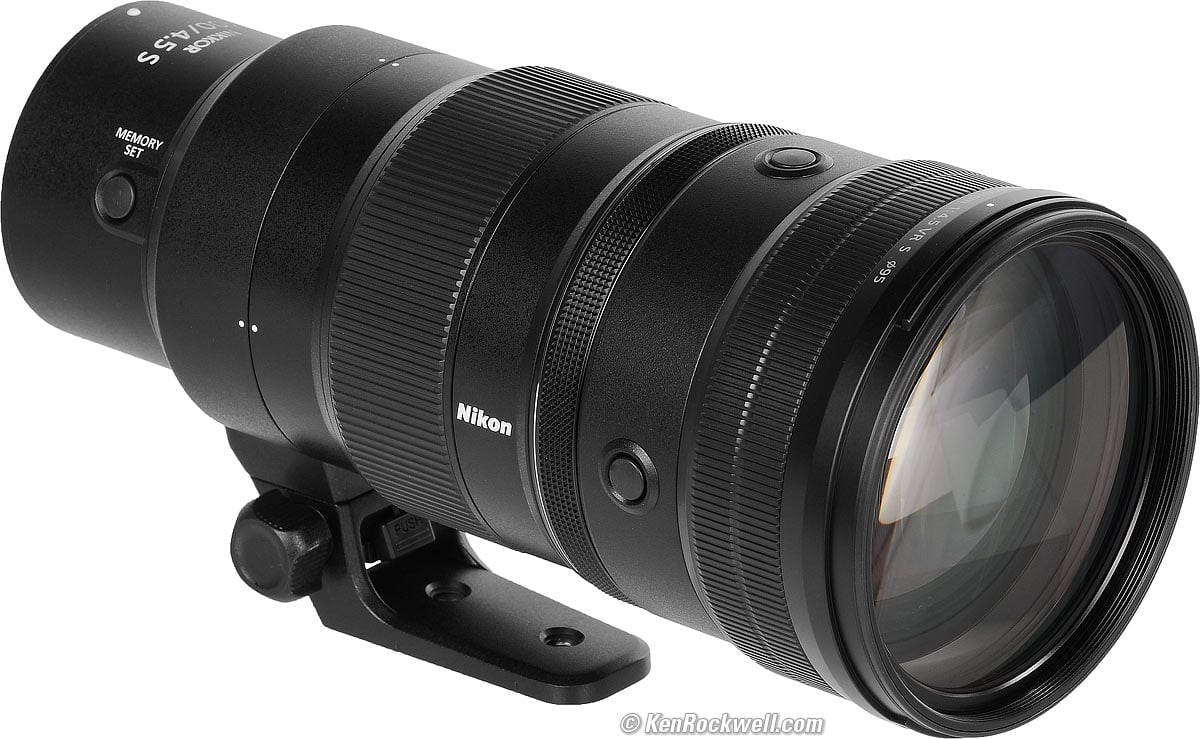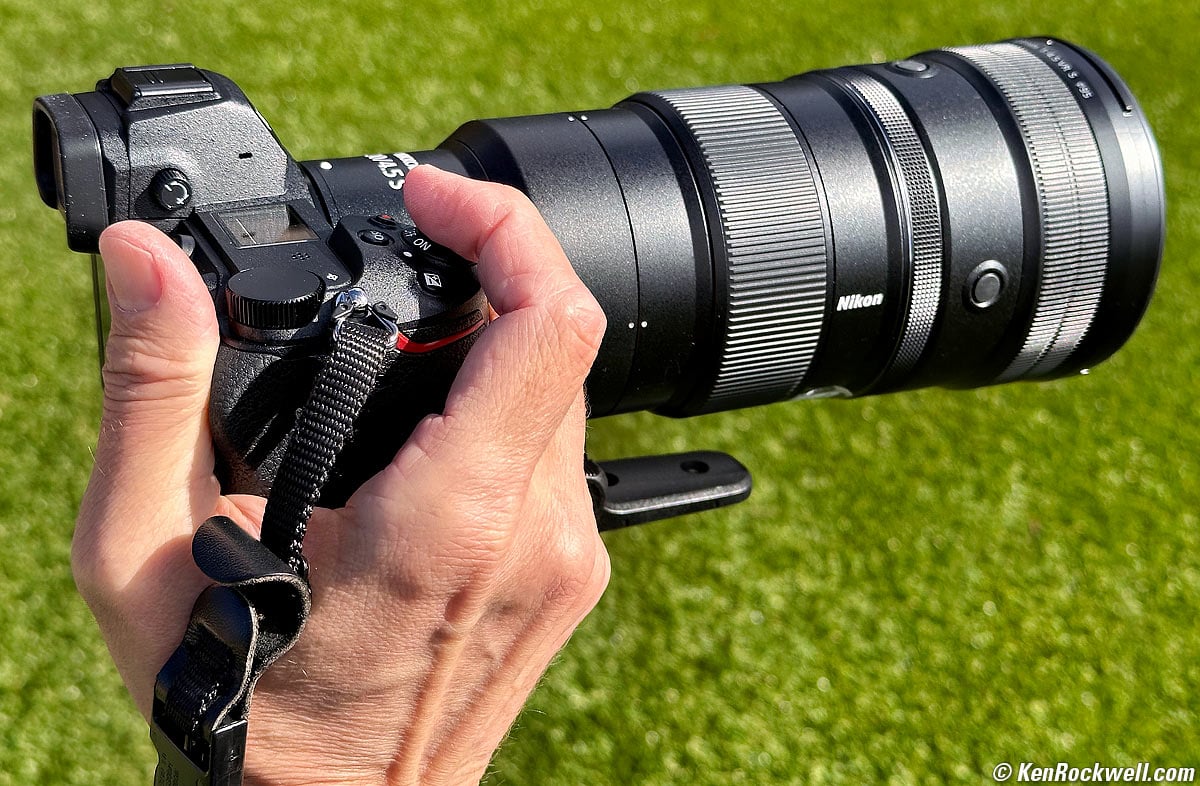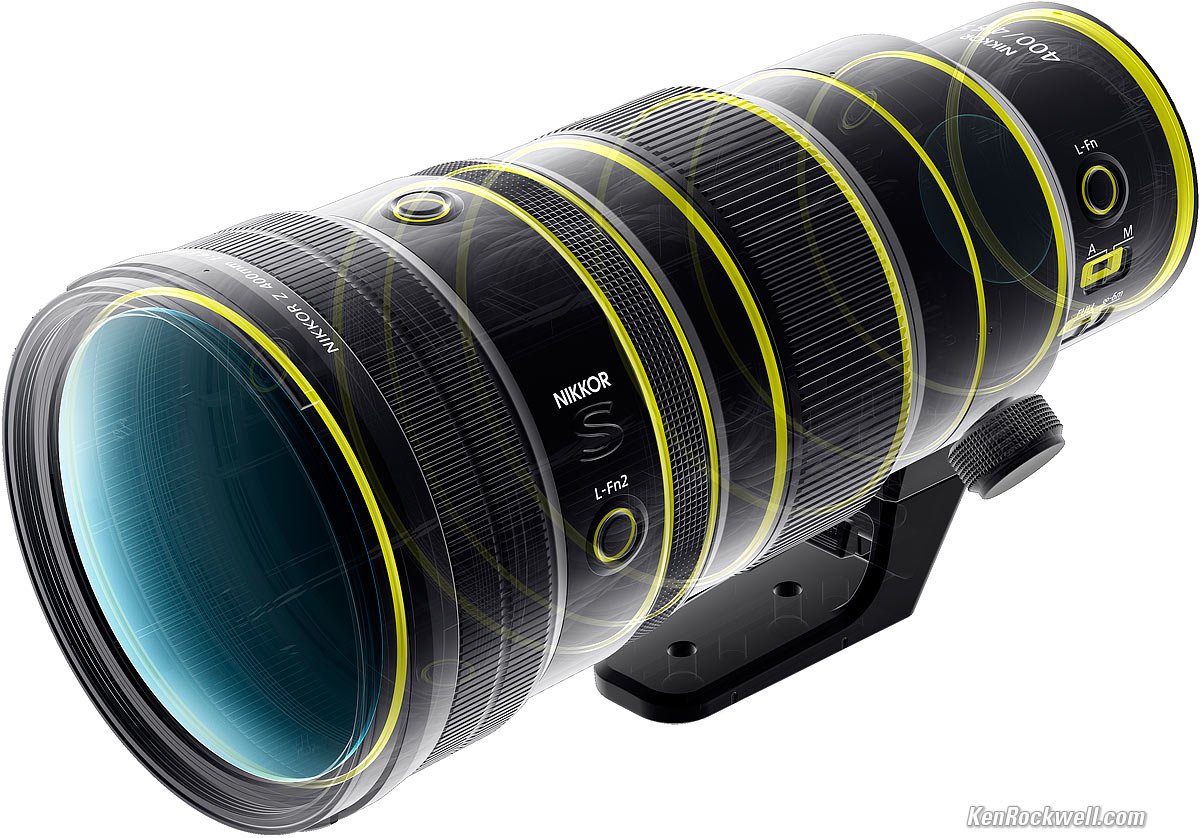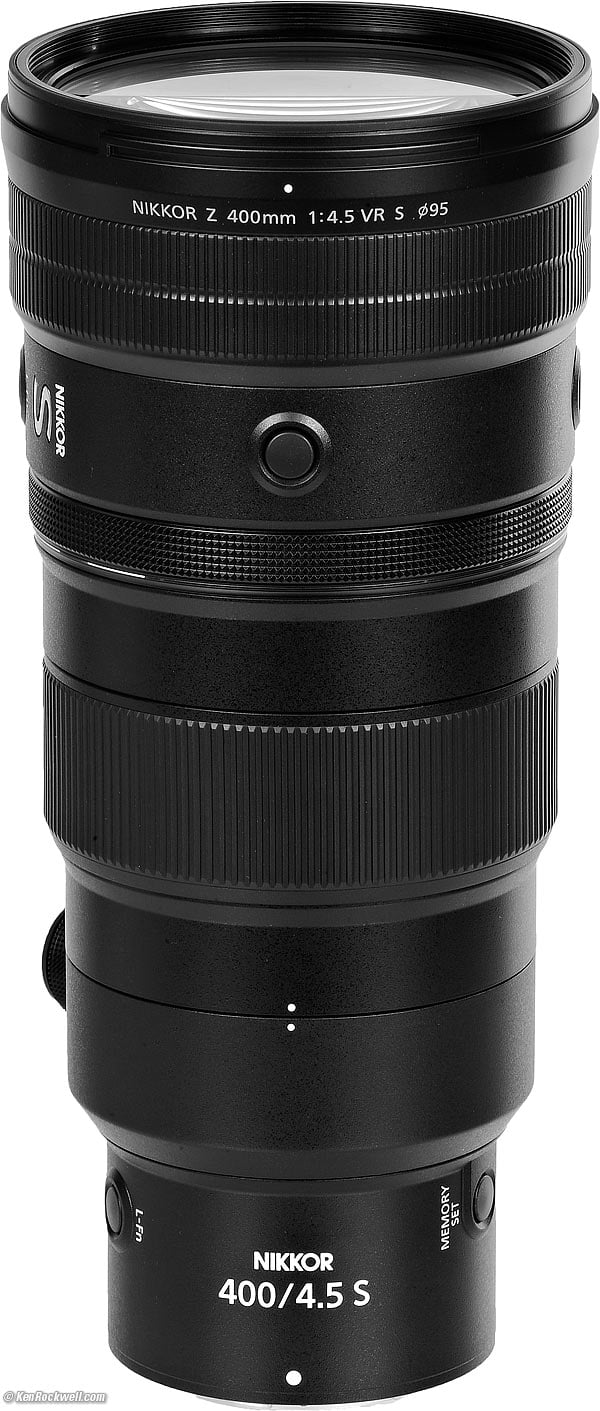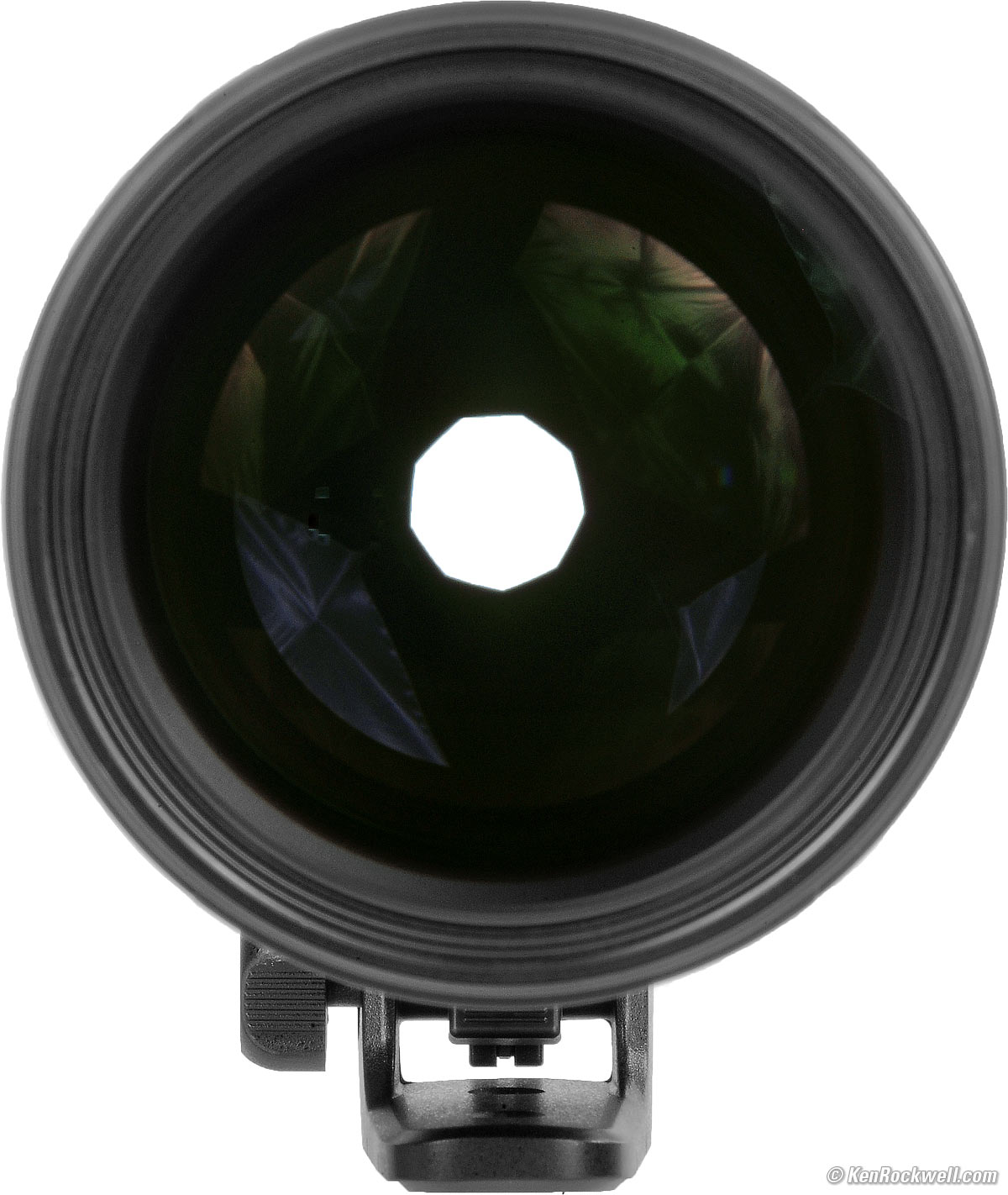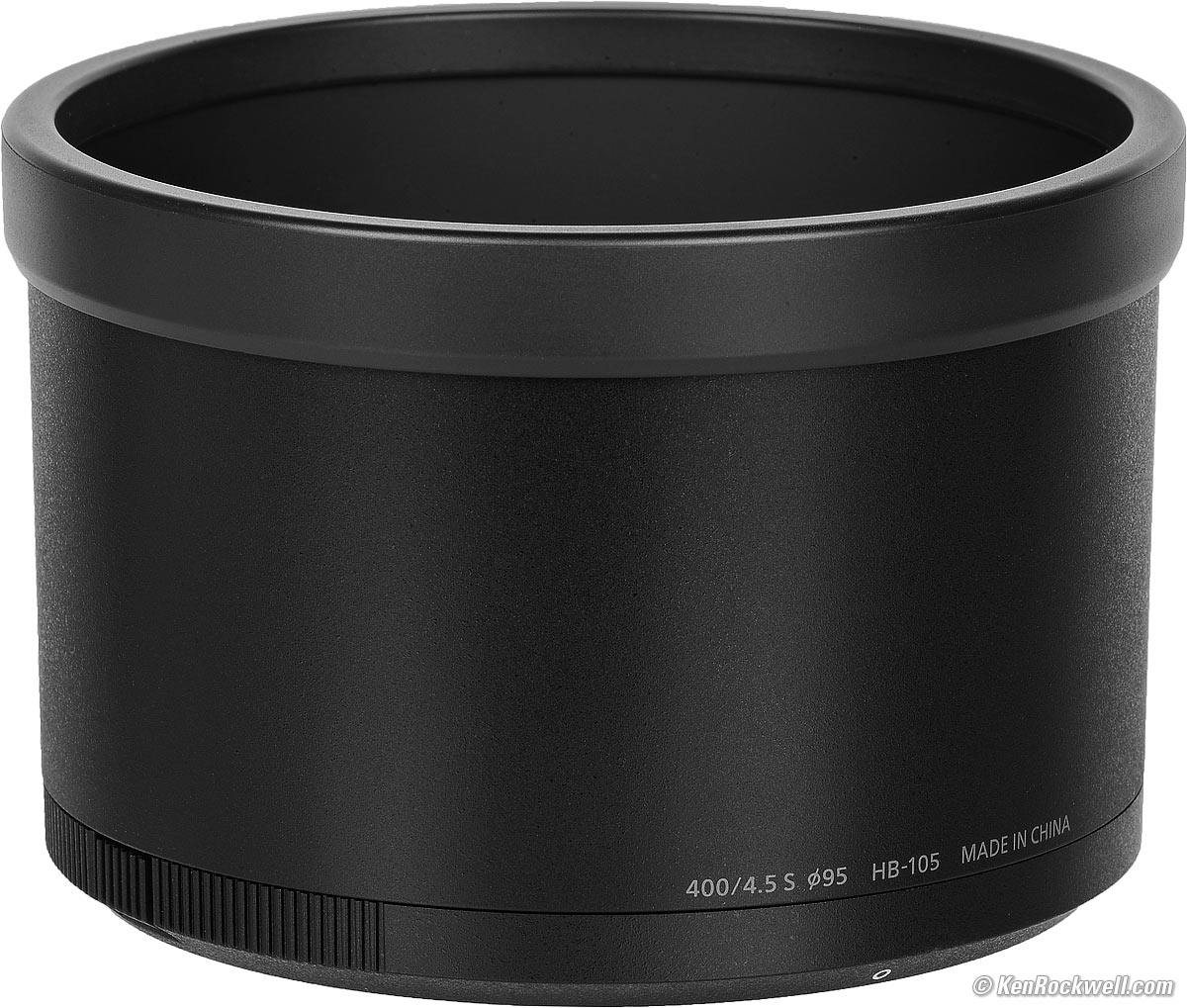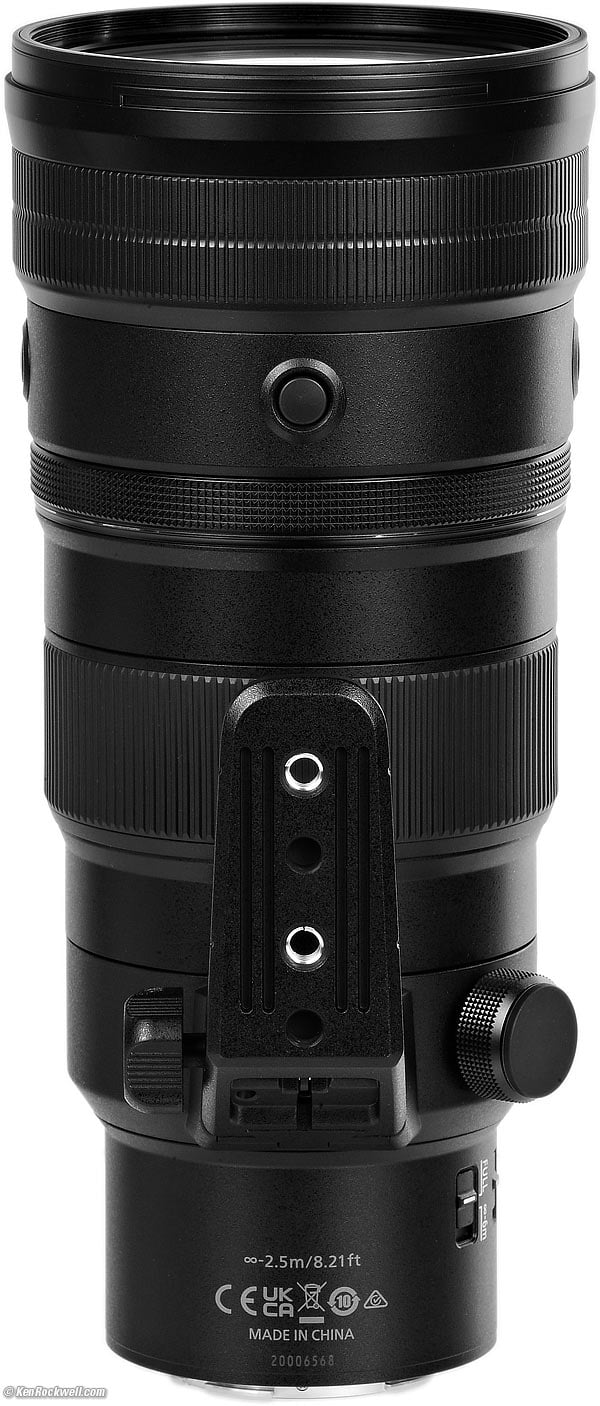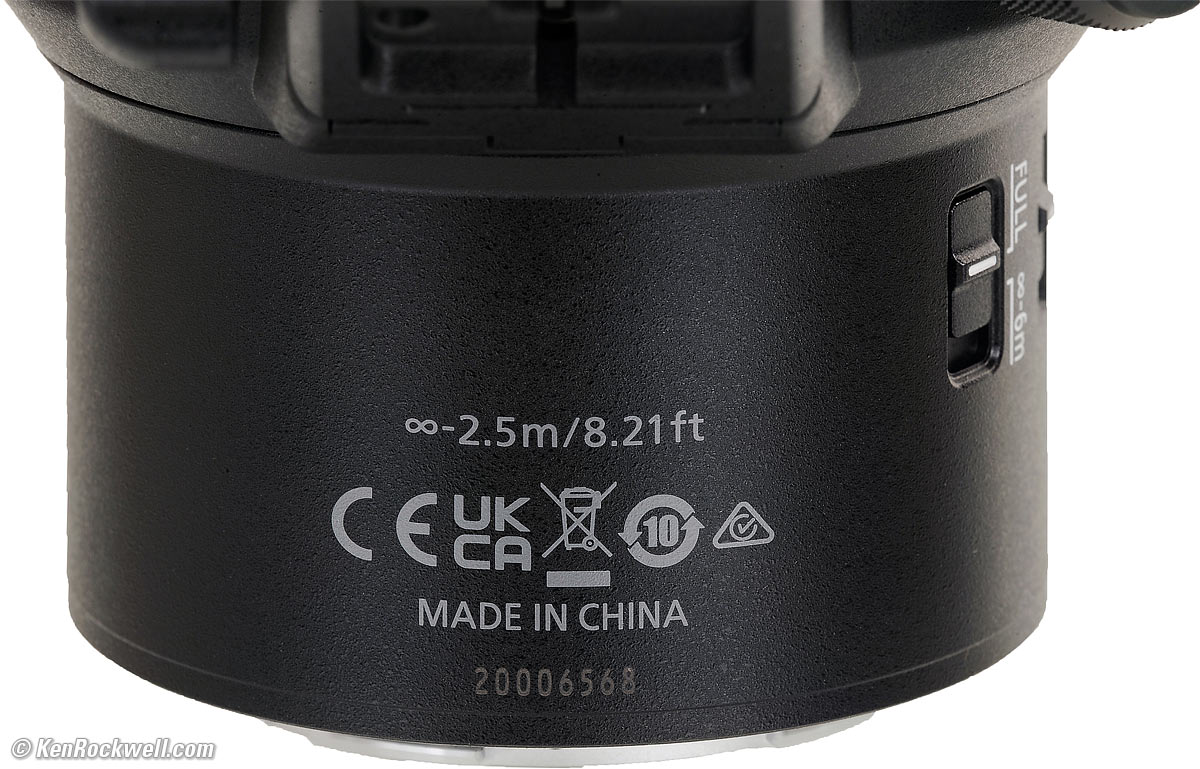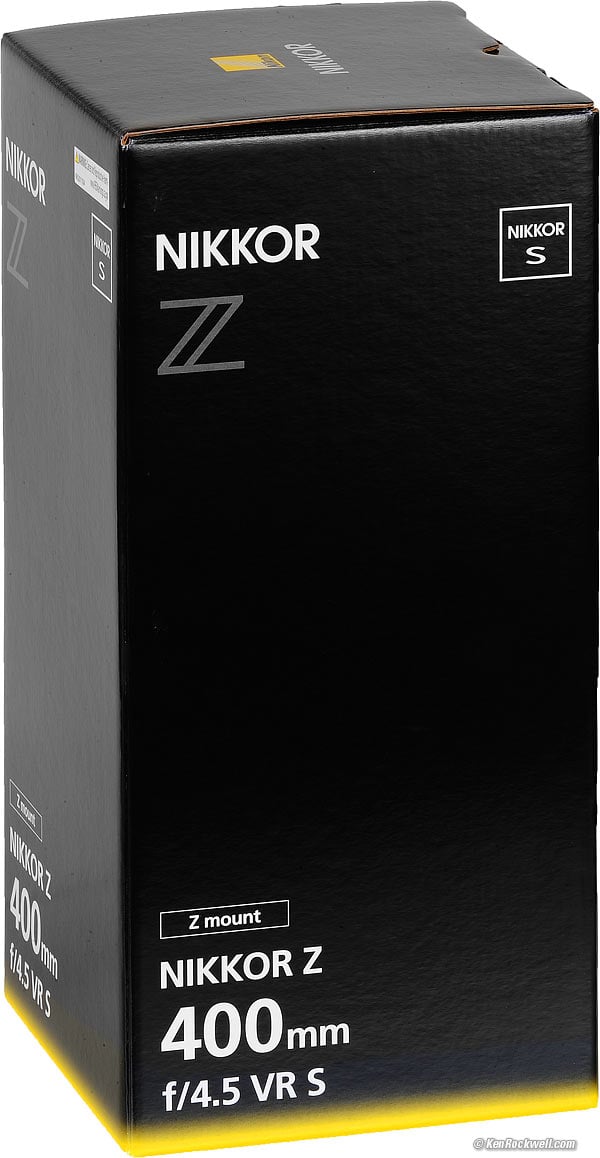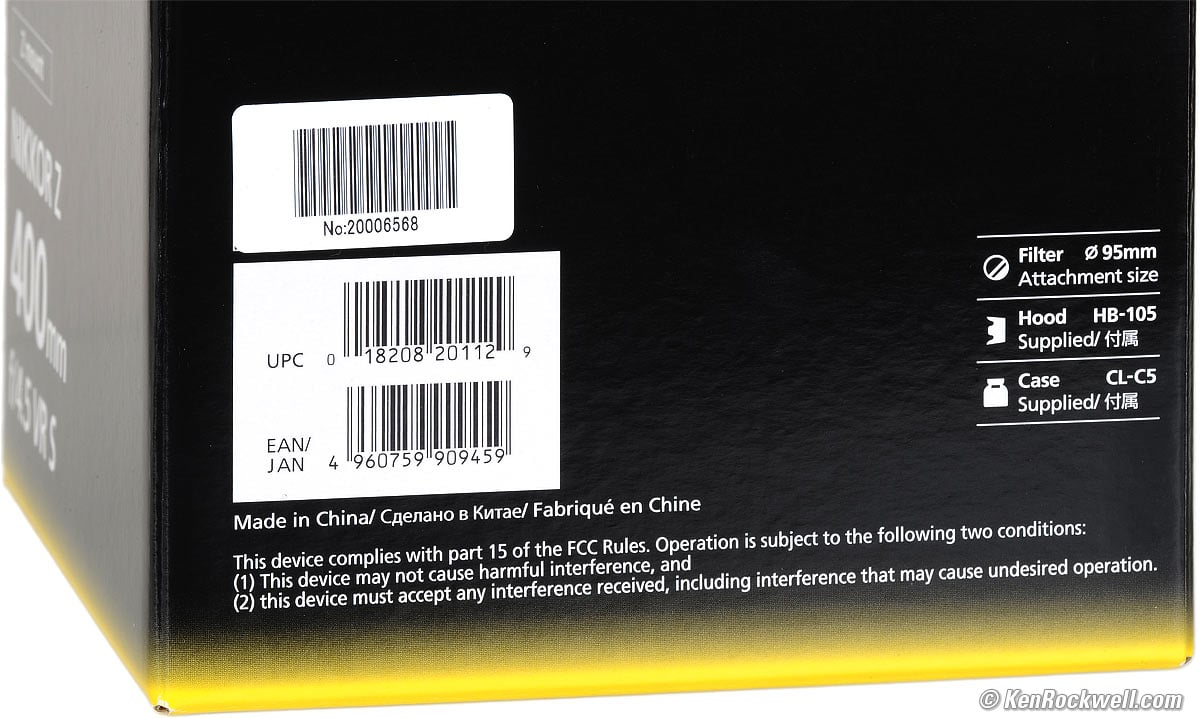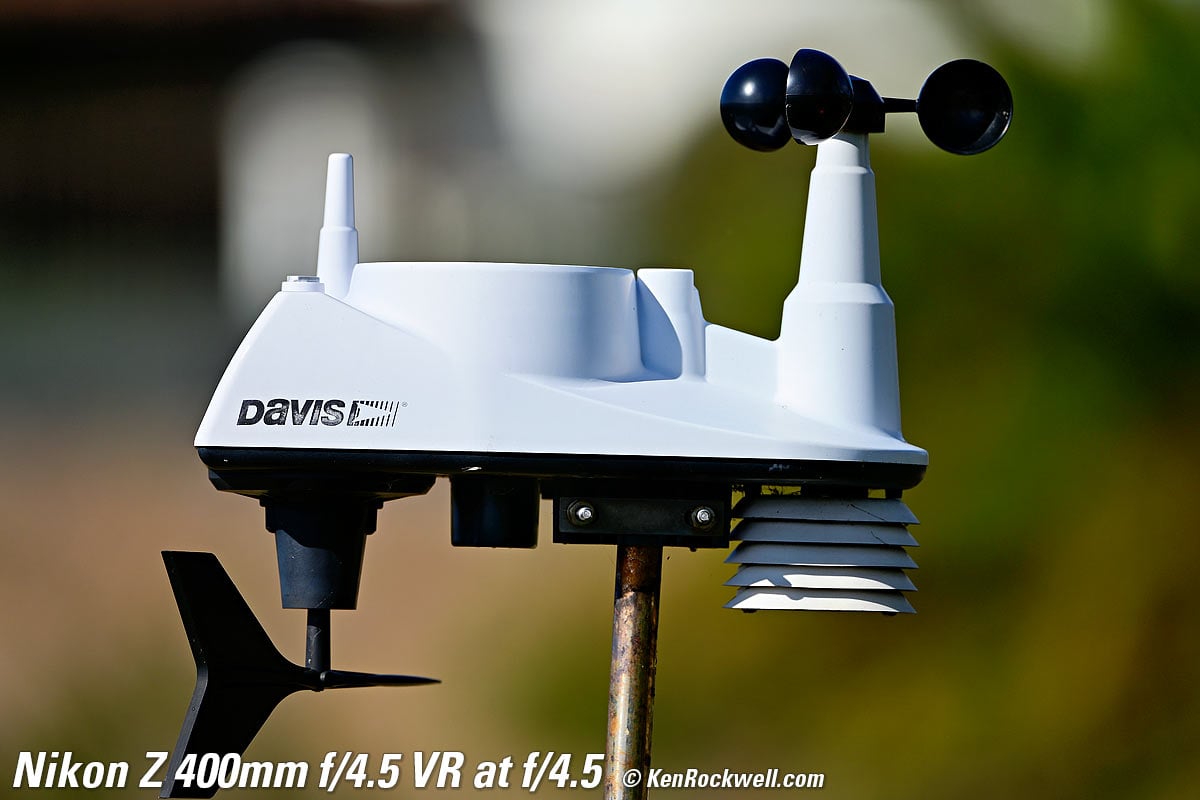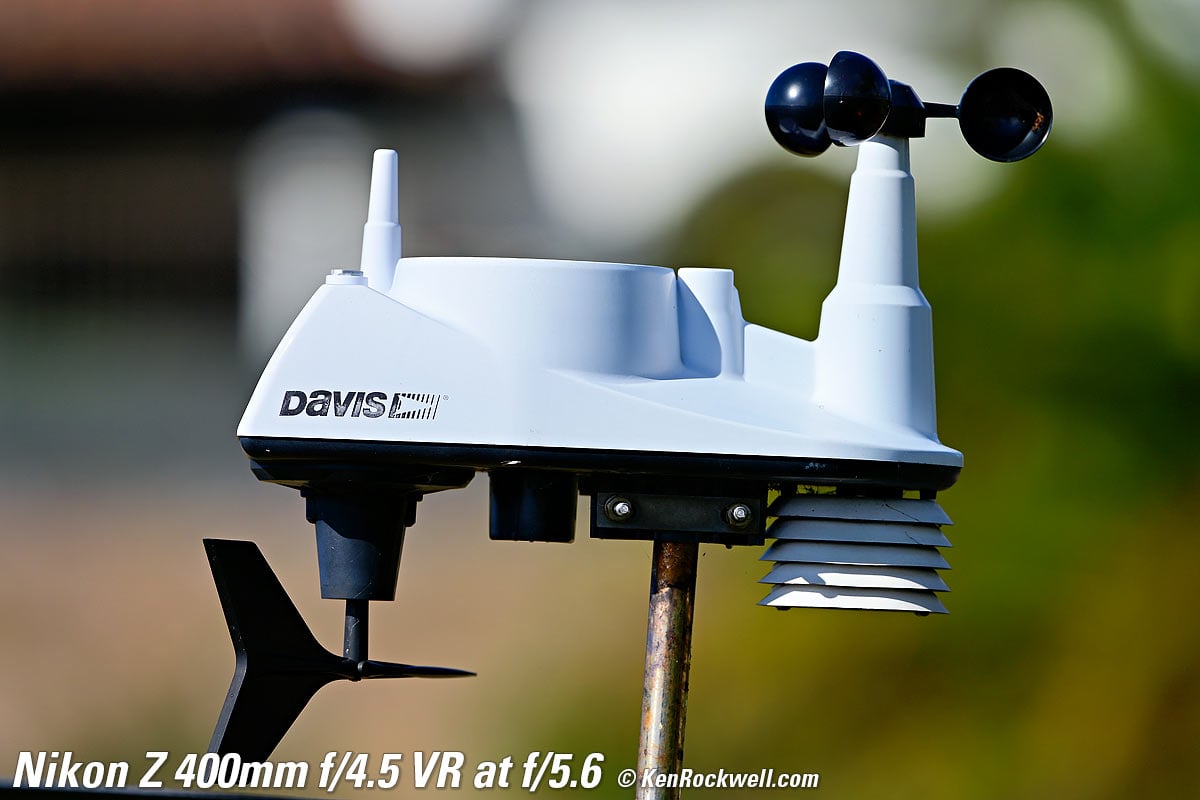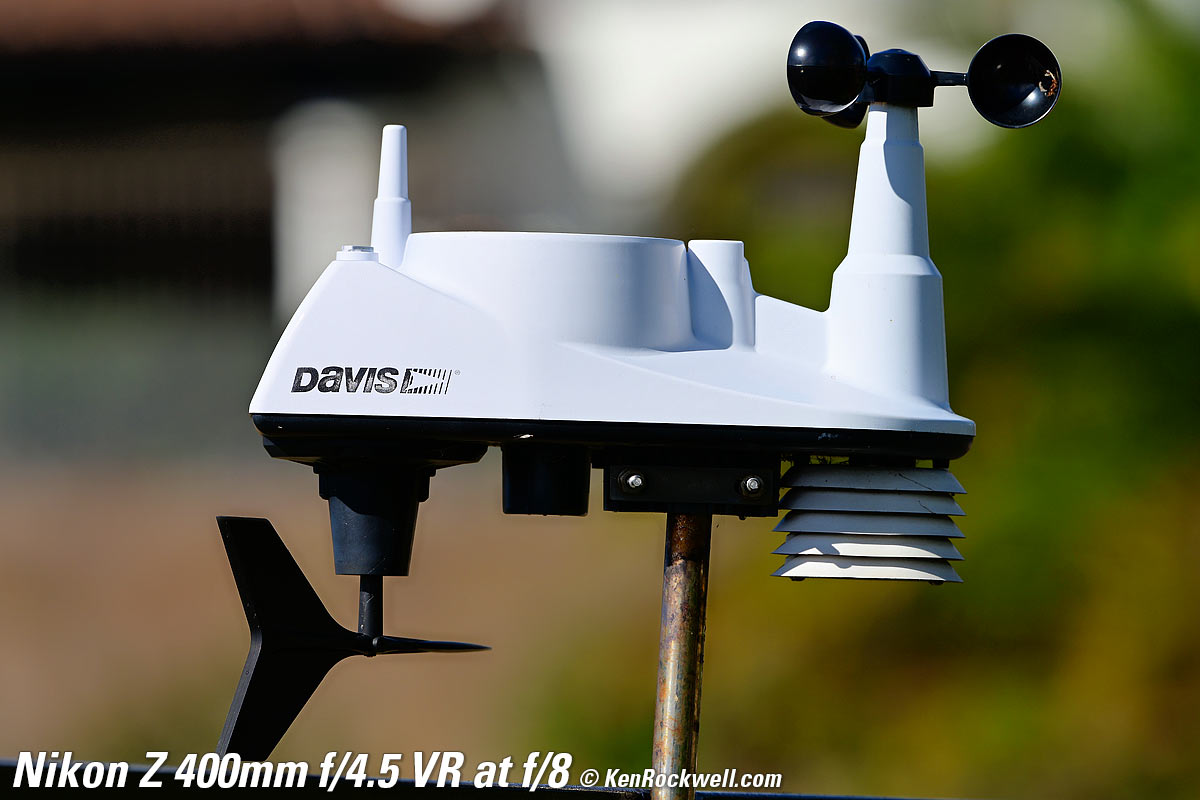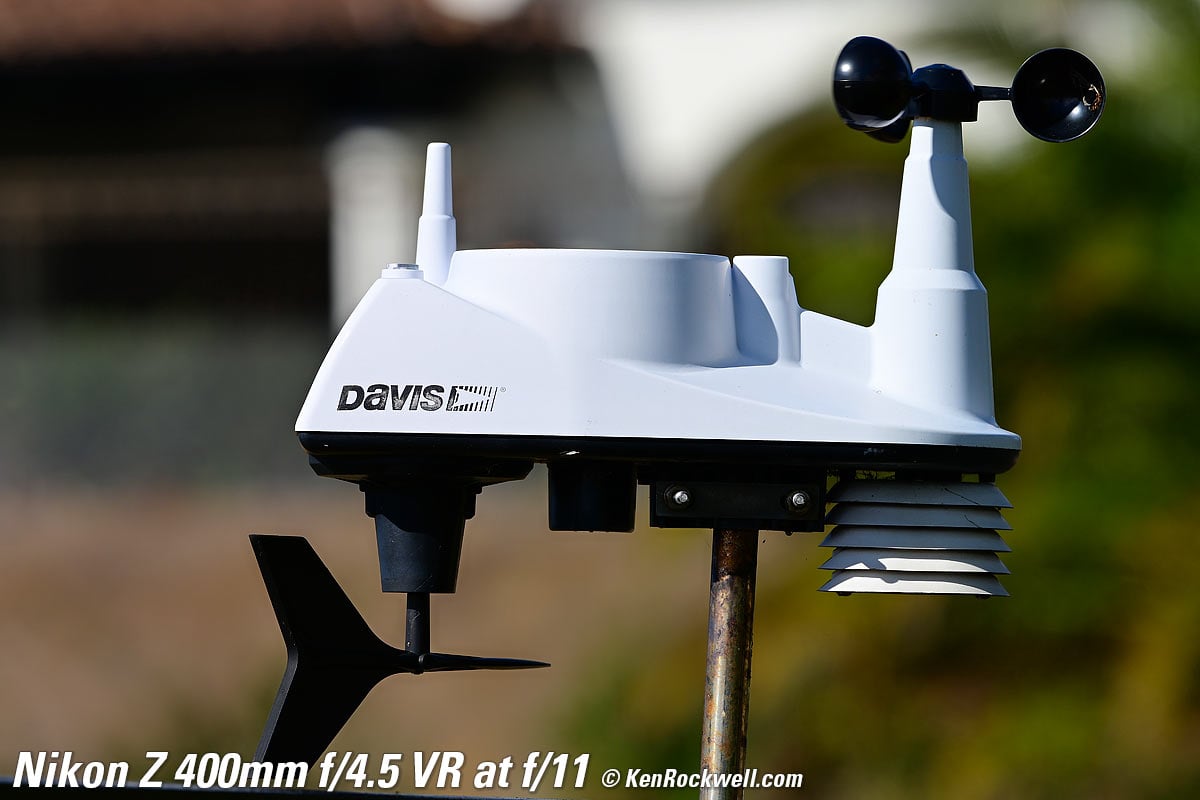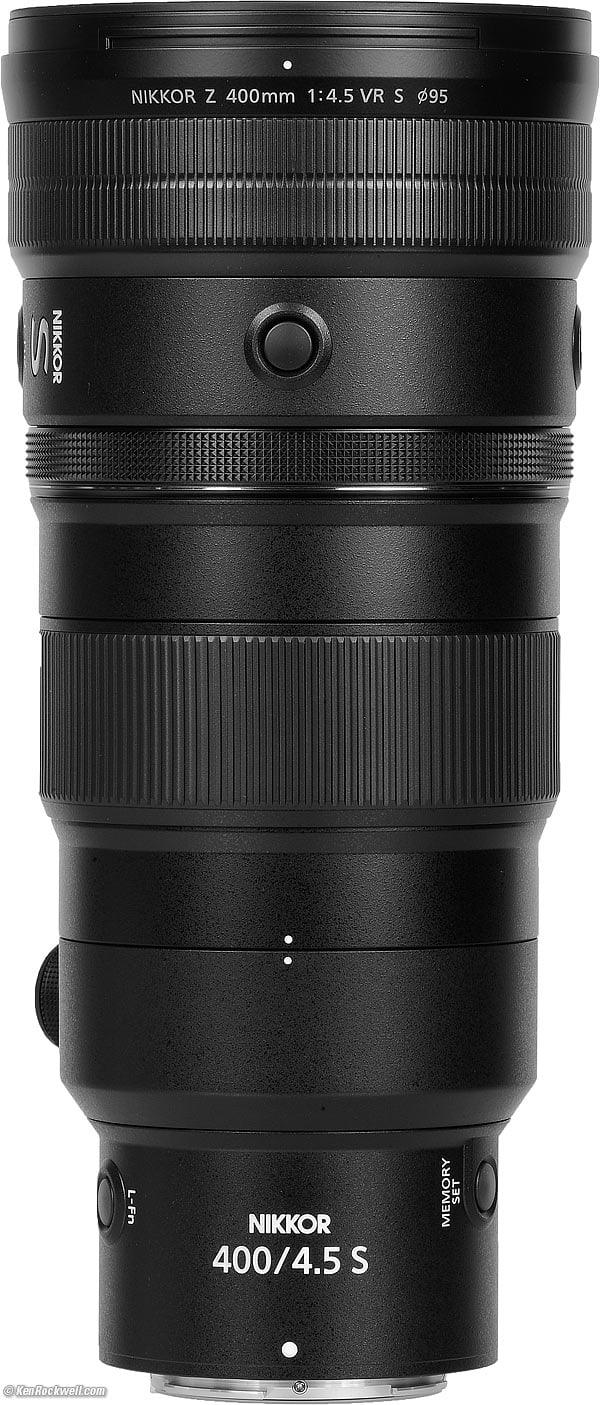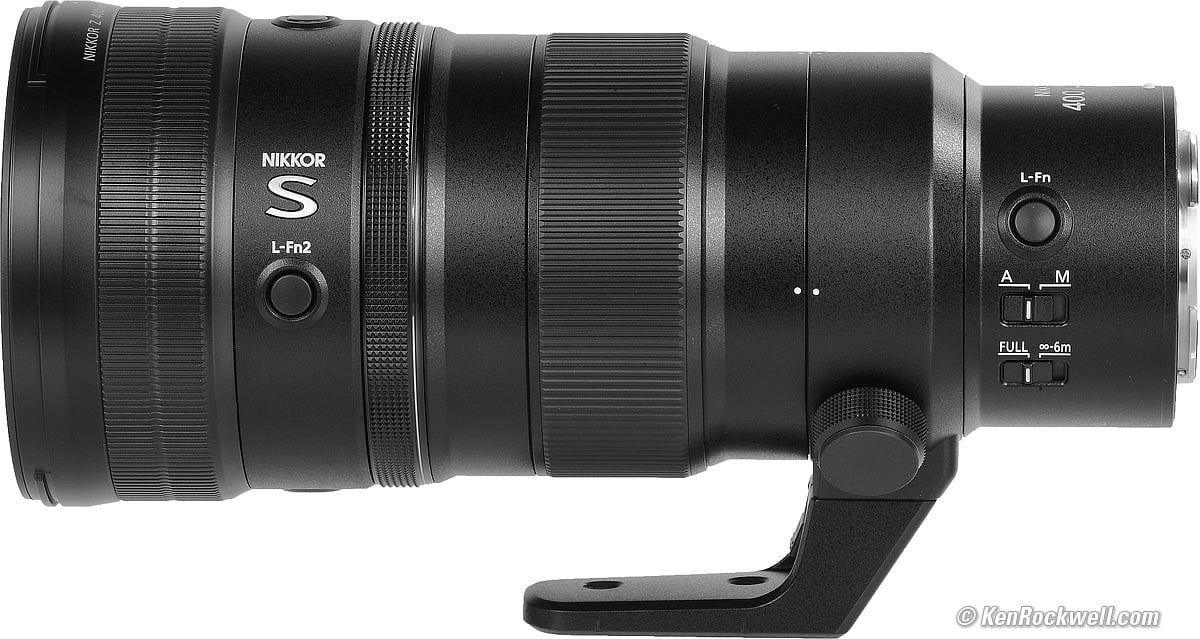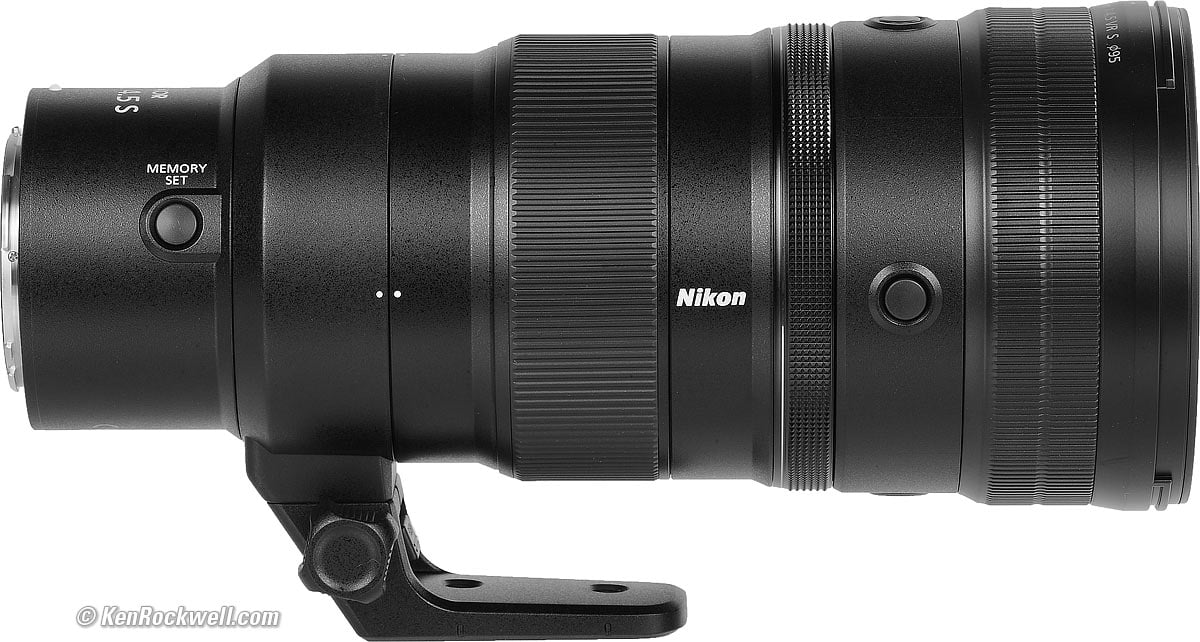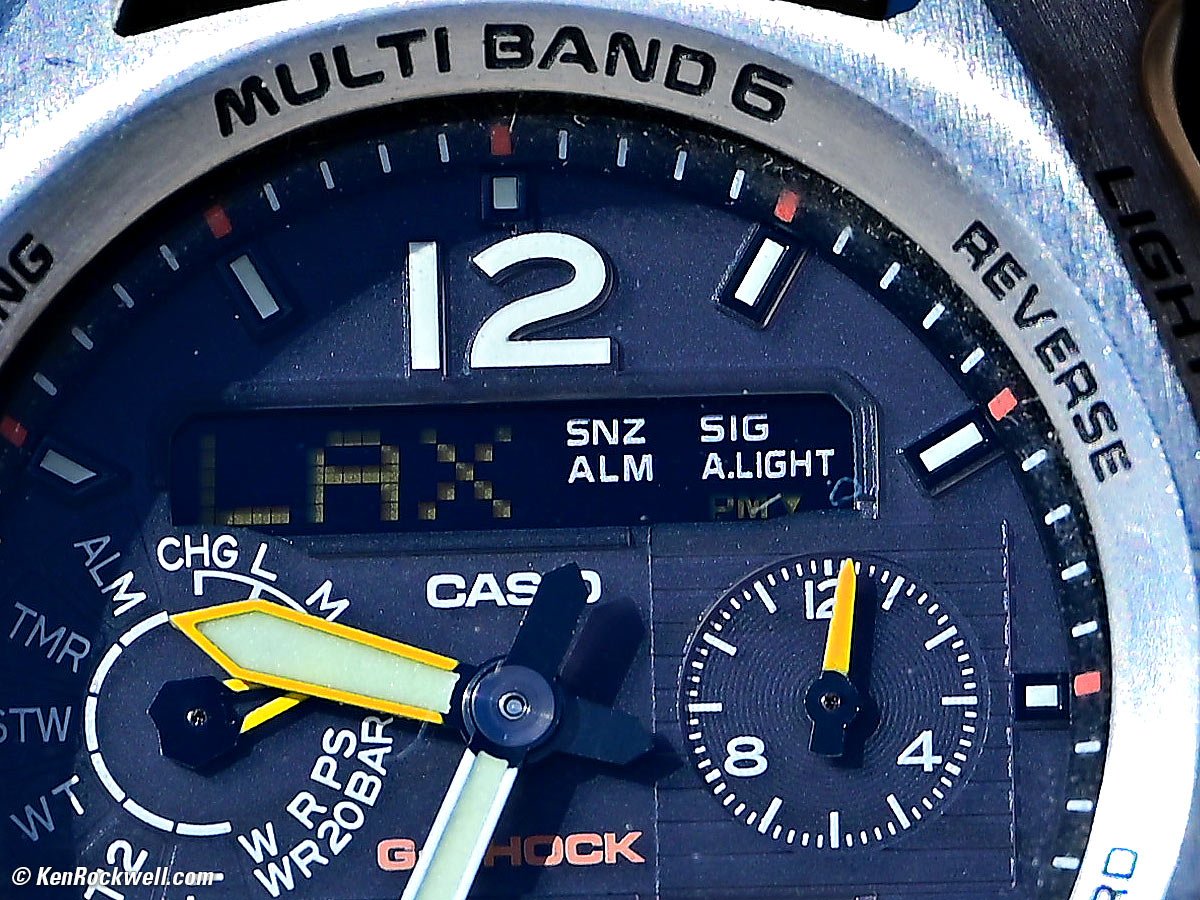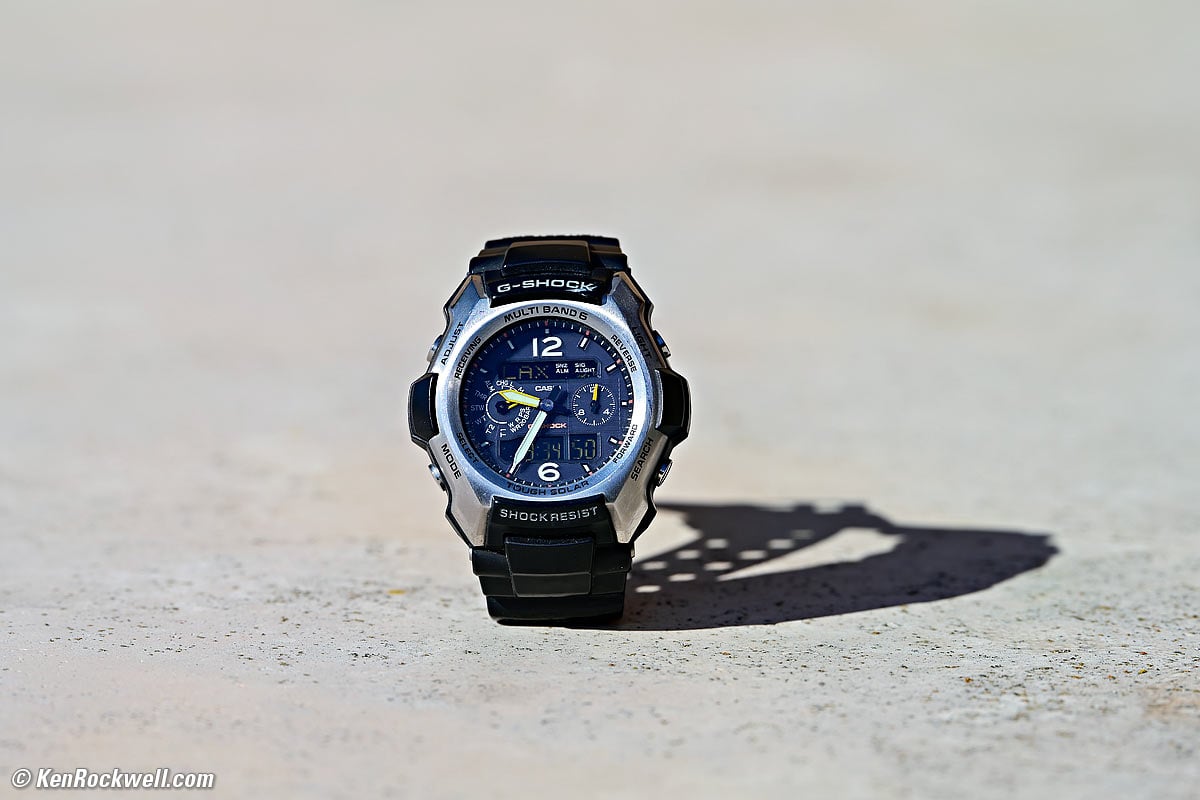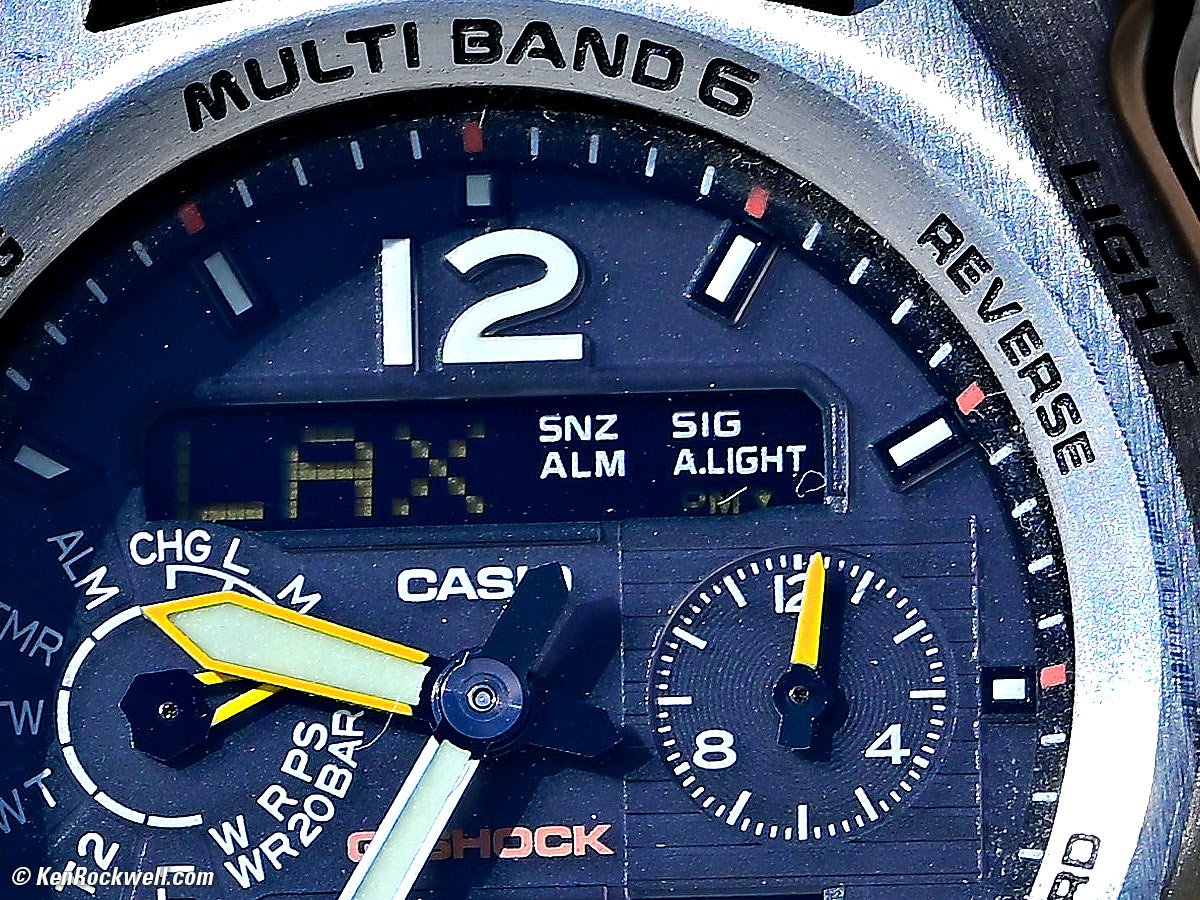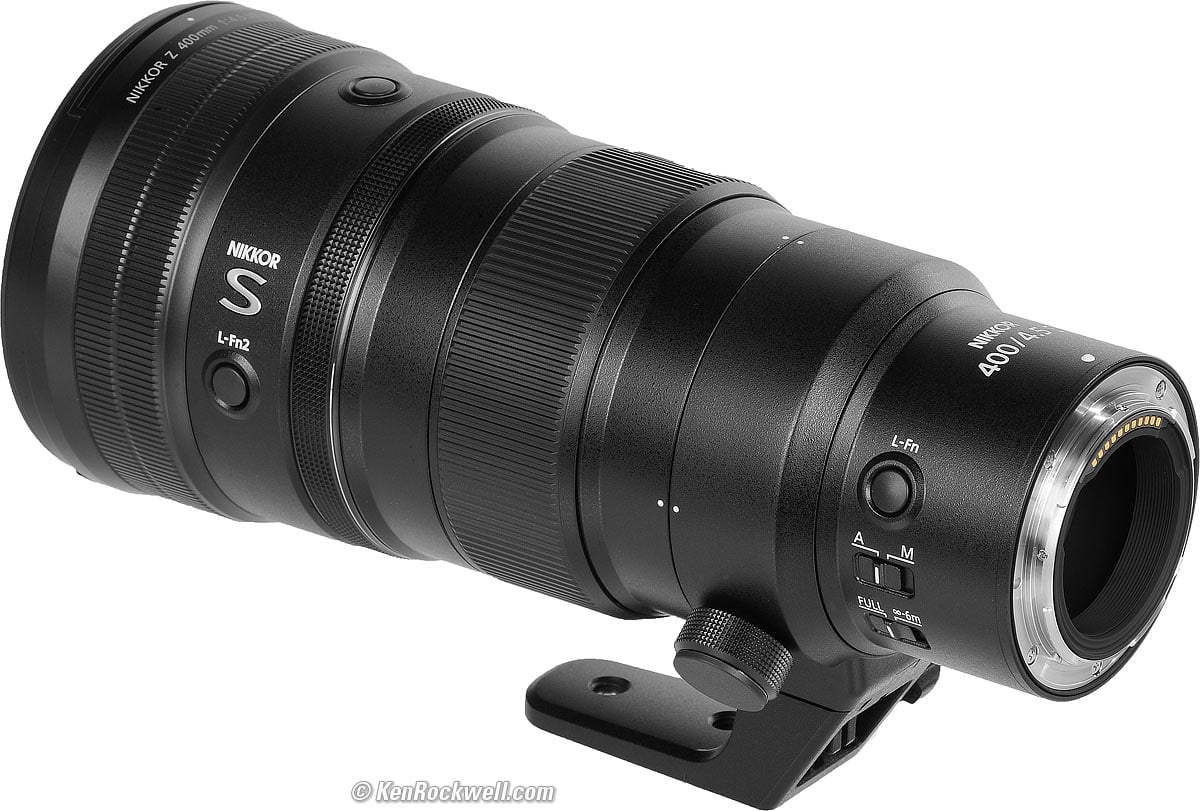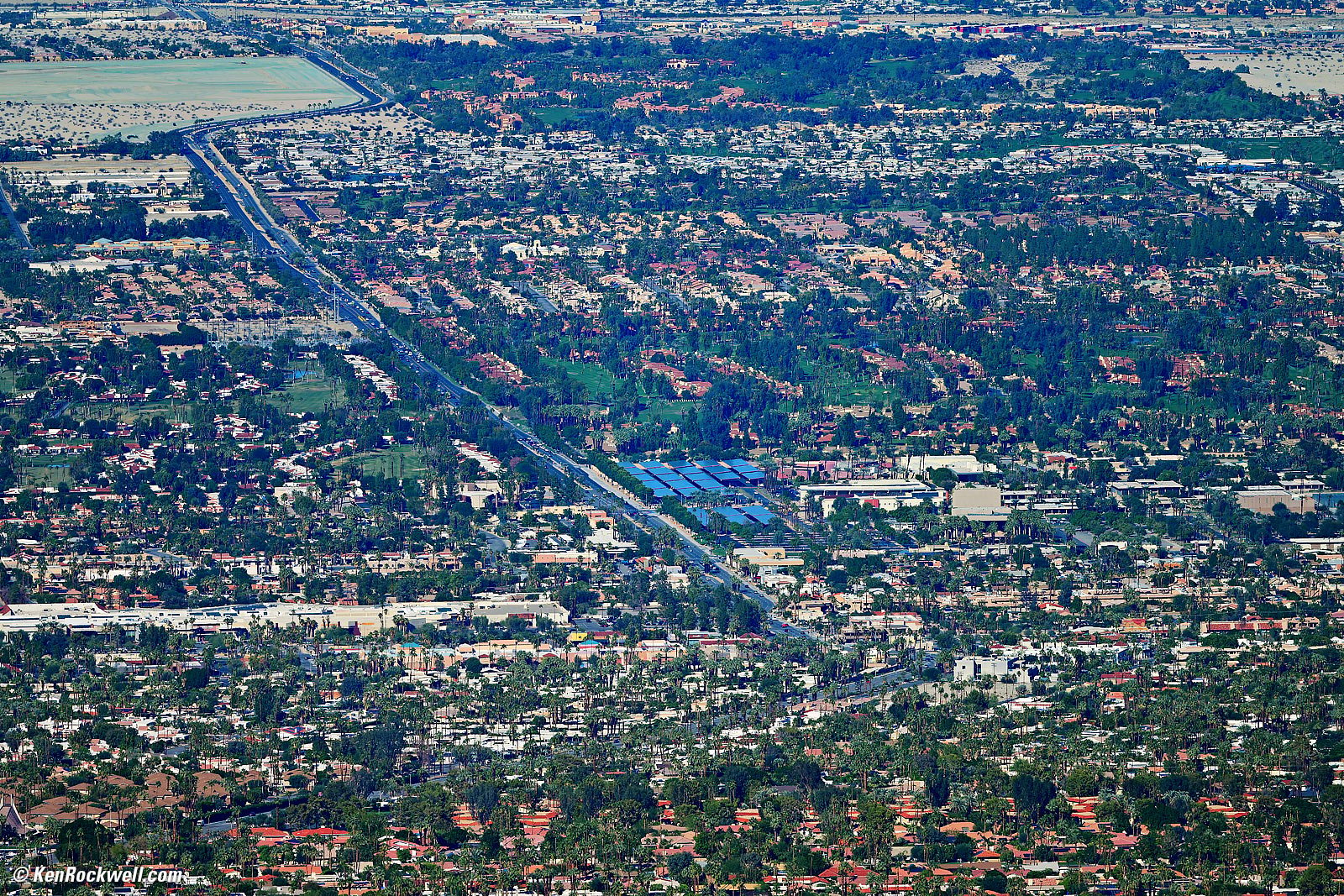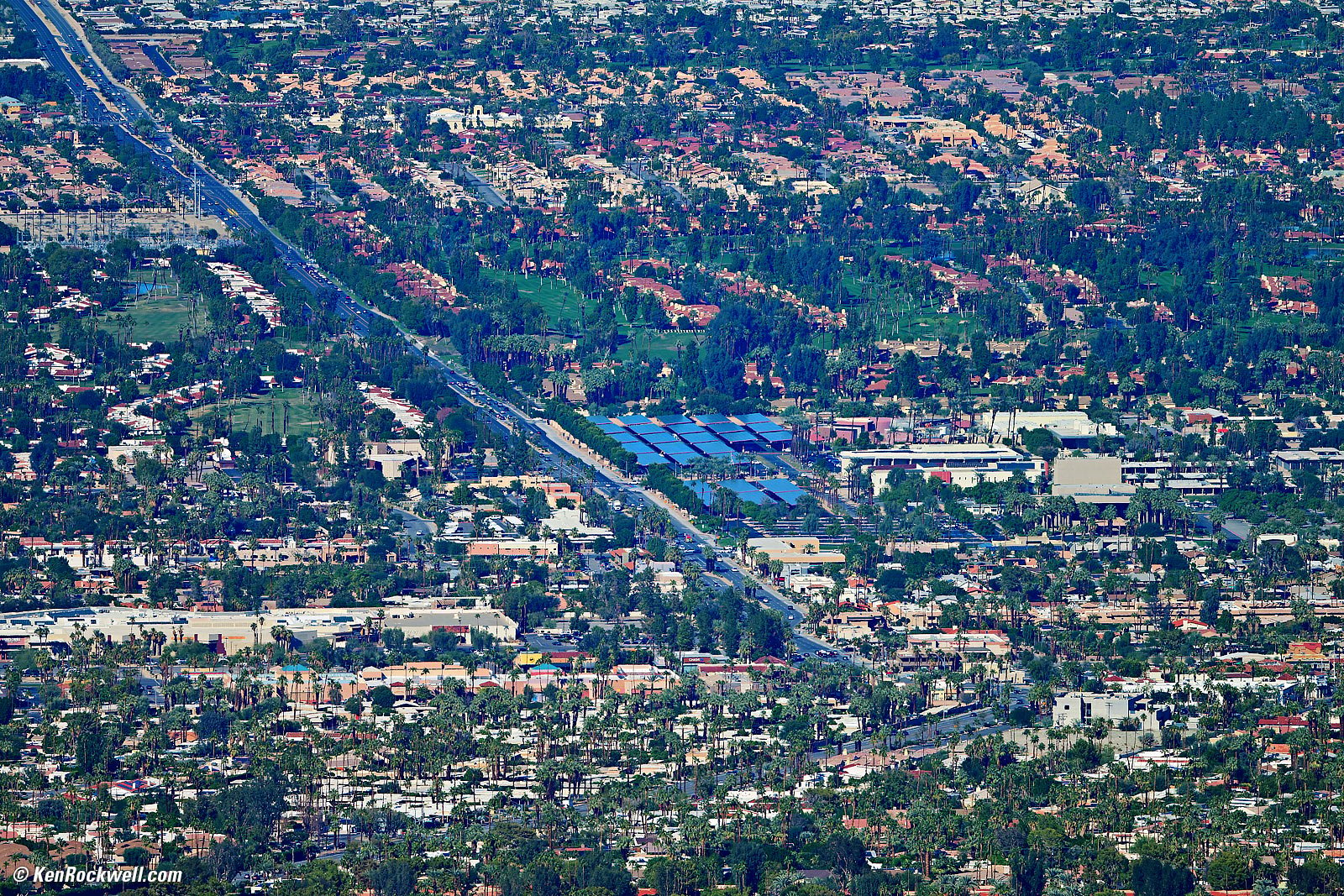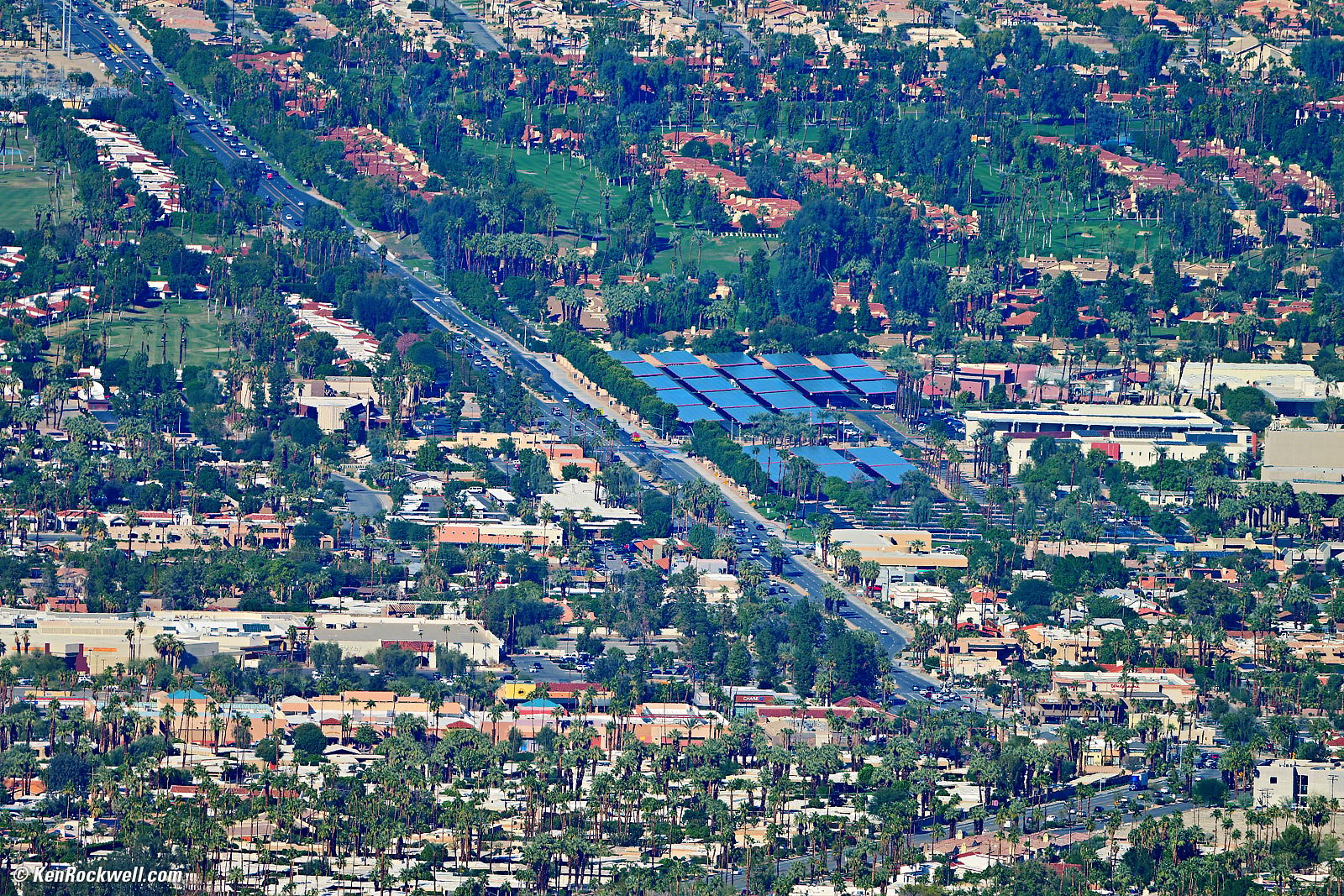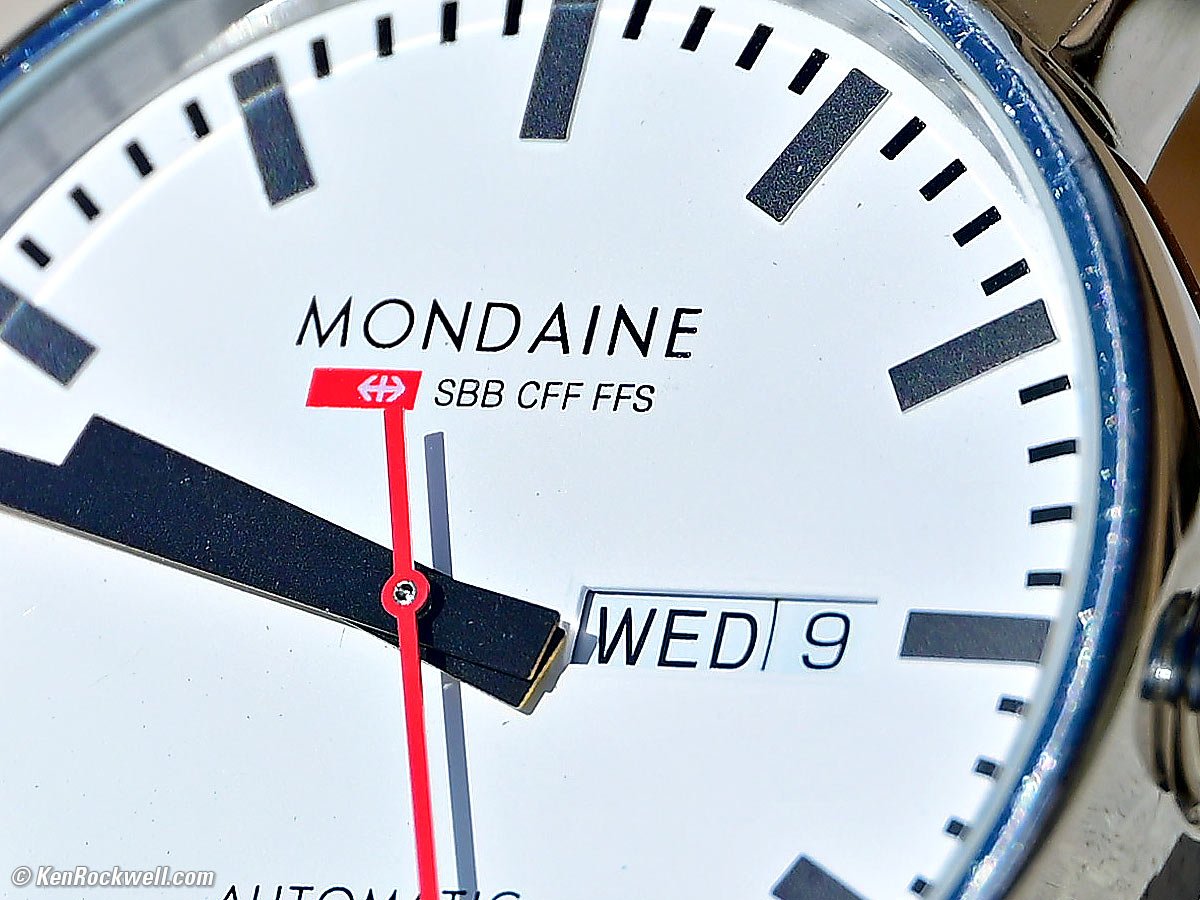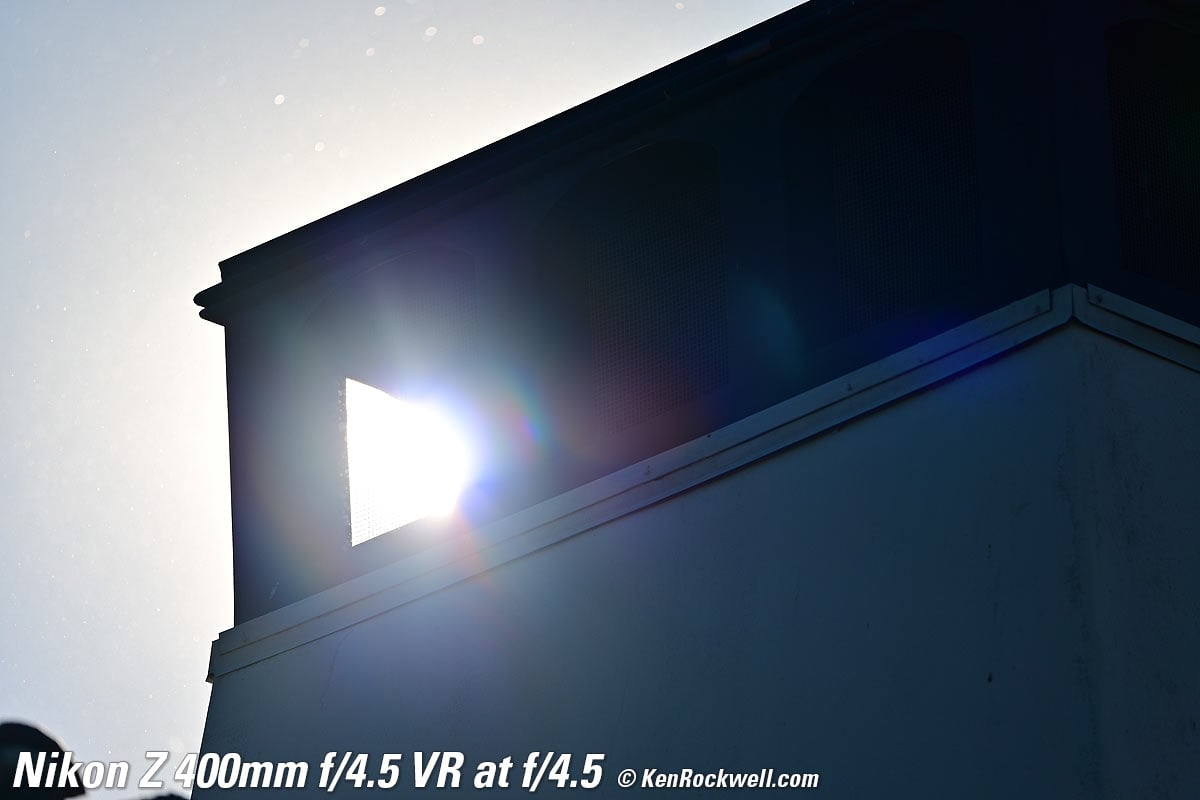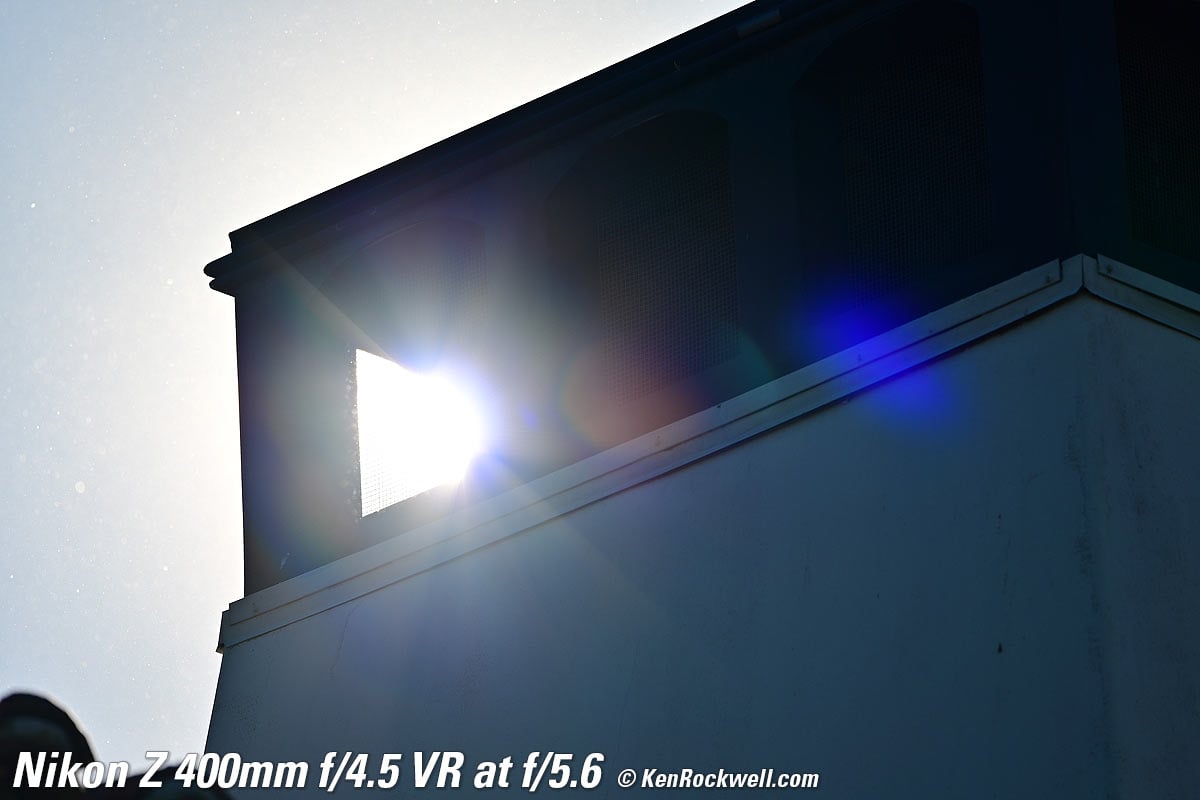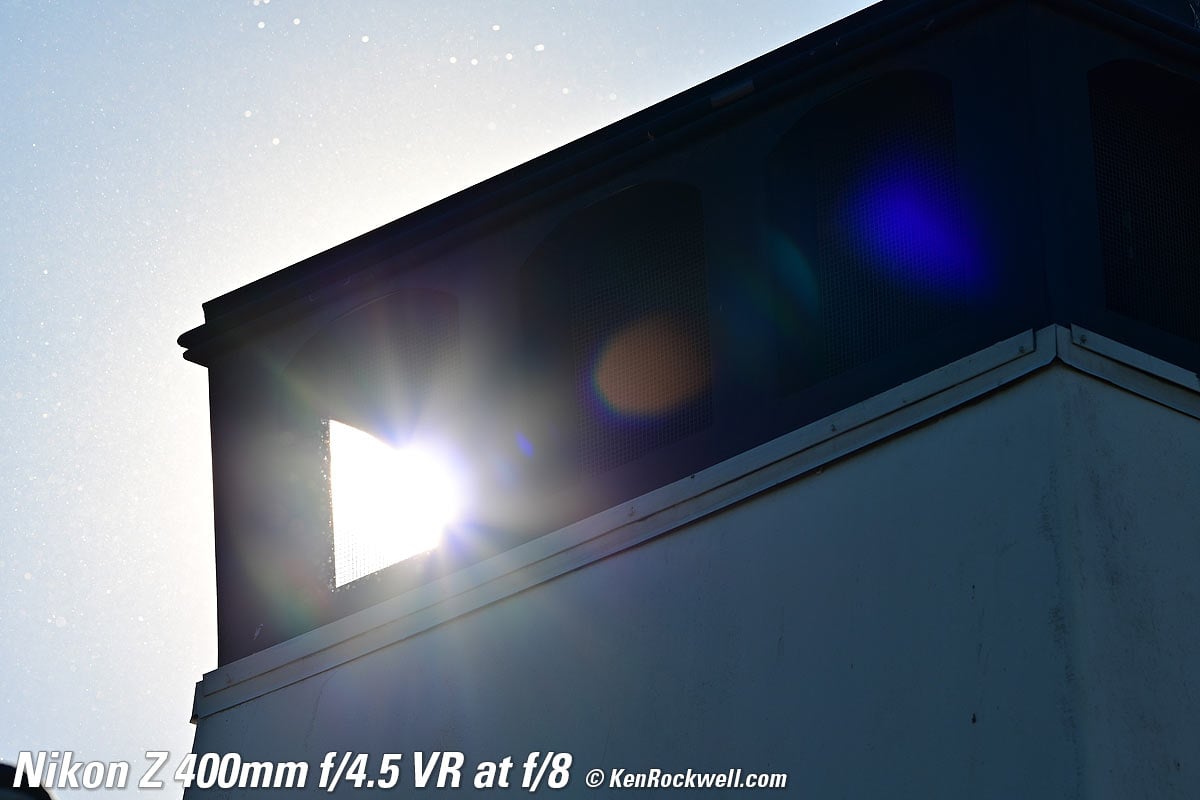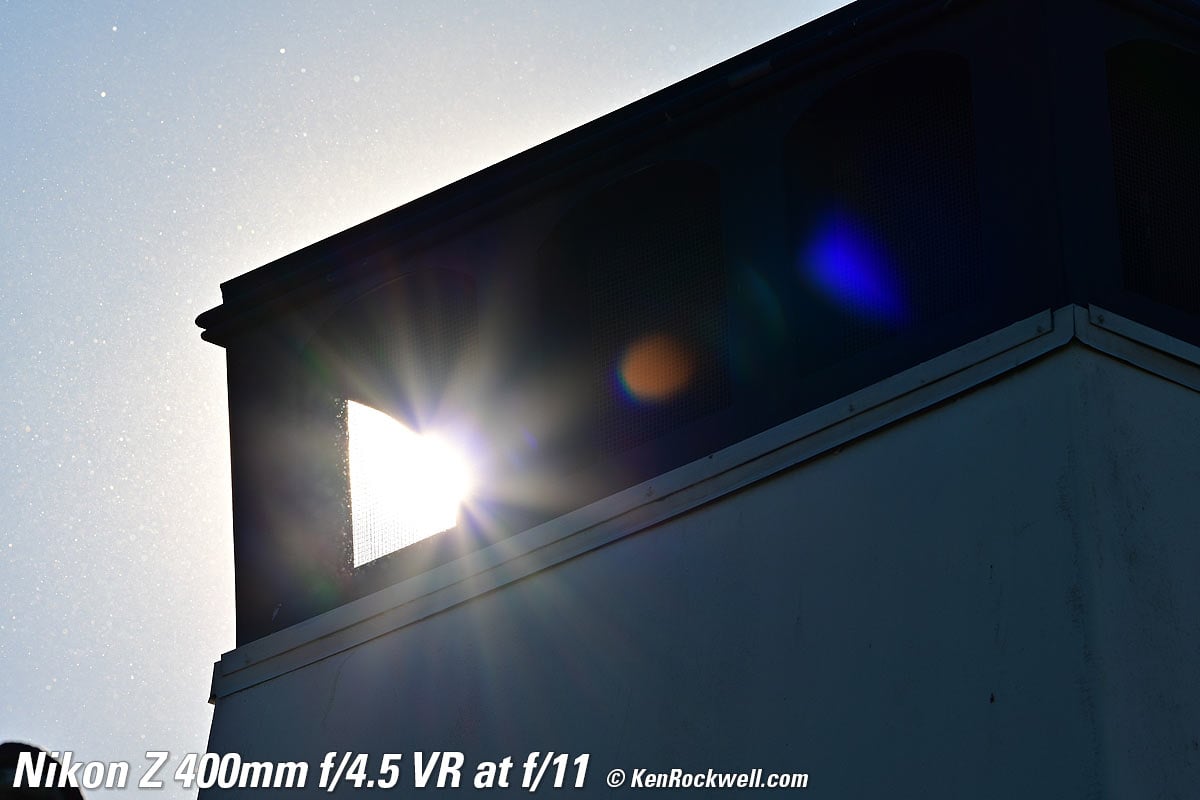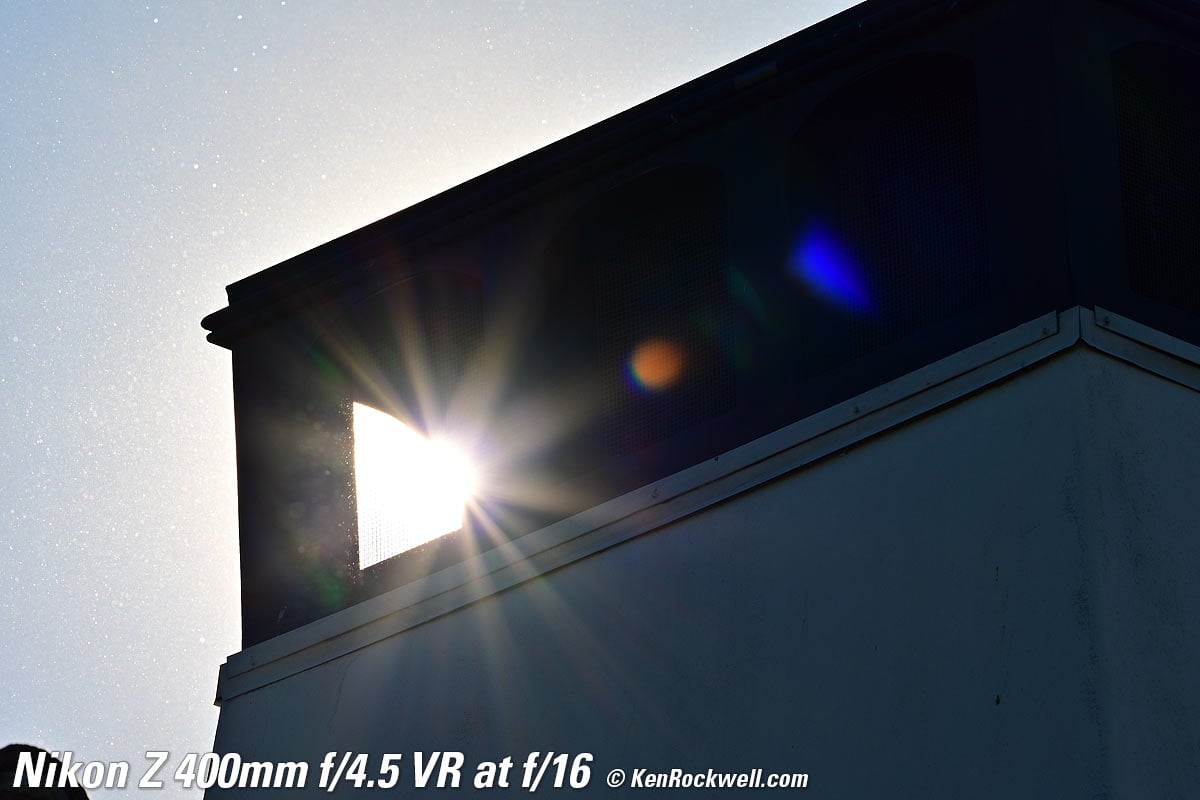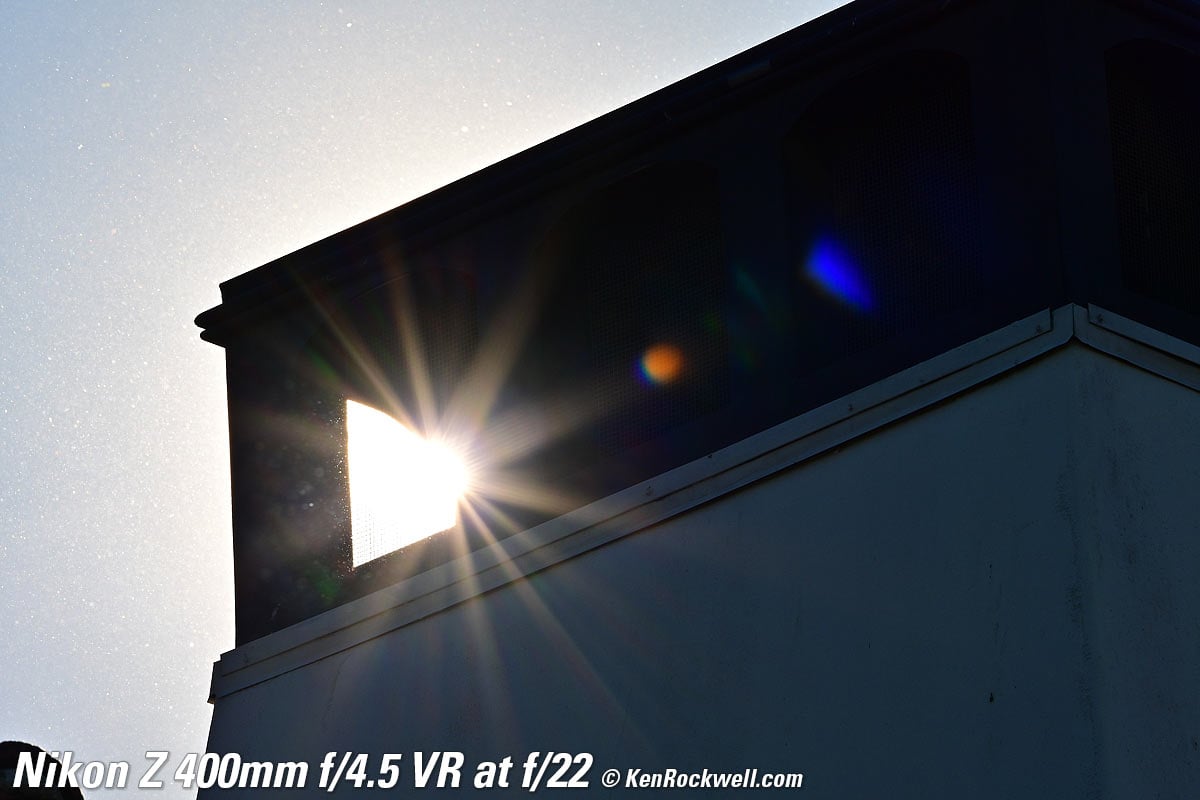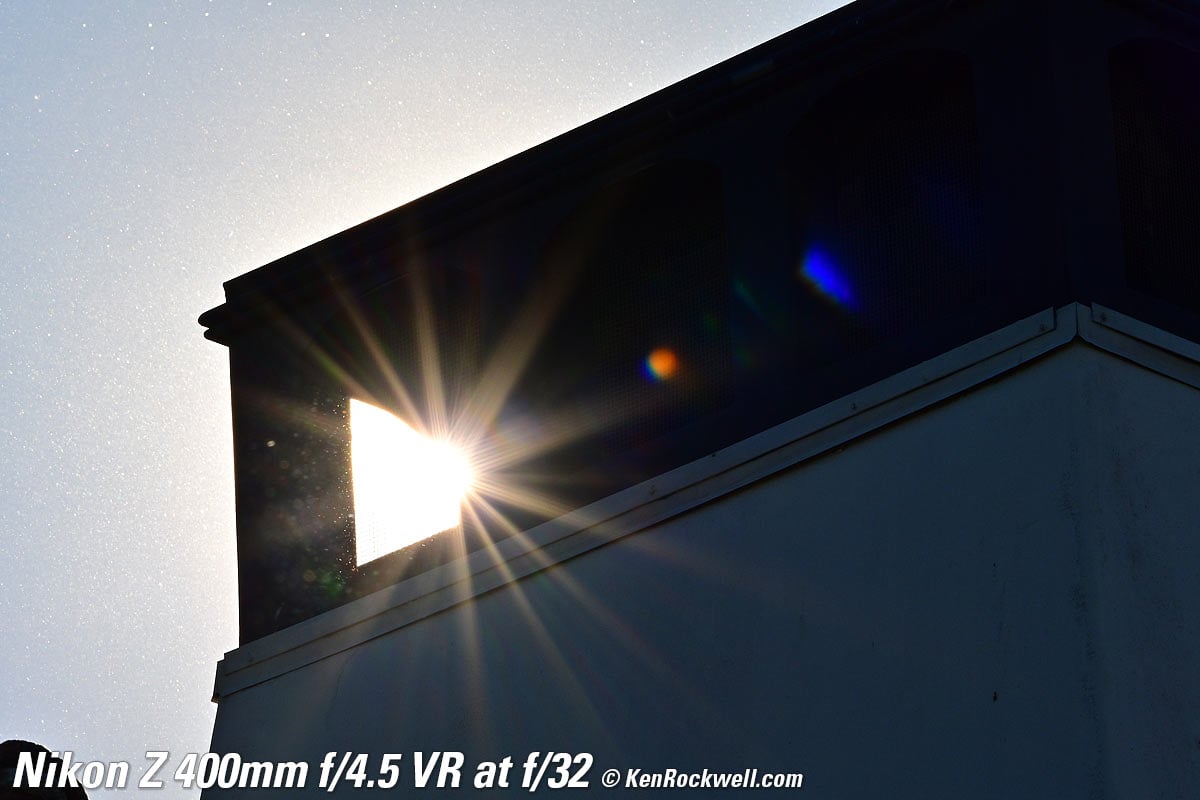Nikon Z 400mm f/4.5 VR
Full-Frame Ultra-light Ultra-Telephoto
Sample Images Intro New Good Bad Missing
Compatibility Specifications Performance
Compared User's Guide Recommendations
Z9 Z8 Z7 II Z6 II Zf Z7 Z6 Z5 Z fc Z50 Z30
Z System Z Lenses All Nikon Lenses Flash
Nikon Z 400mm f/4.5 VR (95mm filters, 43.9 oz./1,245g with tripod collar, 40.9 oz./1,160g without, 8'/2.5m close focus, 0.16 × macro ratio, $3,247). bigger. I'd get mine at Adorama, at Amazon, at B&H or at Crutchfield, or used at eBay if you know How to Win at eBay.
This 100% all-content, junk-free website's biggest source of support is when you use those or any of these links to my personally approved sources I've used myself for way over 100 combined years when you get anything, regardless of the country in which you live — but I receive nothing for my efforts if you get it elsewhere. Nikon does not seal its boxes in any way, so never buy at retail or any other source not on my personally approved list since you'll have no way of knowing if you're missing accessories, getting a defective, damaged, returned, dropped, incomplete, gray-market, store demo or used lens — and my personally approved sources allow for 100% cash-back returns for at least 30 days if you don't love your new lens. I've used many of these sources since the 1970s because I can try it in my own hands and return it if I don't love it, and because they ship from secure remote warehouses where no one gets to touch your new 400mm lens before you do. Buy only from the approved sources I've used myself for decades for the best prices, service, return policies and selection.
November 2022 Better Pictures Nikon Mirrorless Mirrorless Lenses All Nikon Lenses Nikon Flash All Reviews
Sony vs. Nikon vs. Canon Full-Frame
Sample Images top
Sample Images Intro New Good Bad Missing
Compatibility Specifications Performance
Compared User's Guide Recommendations
These are just snapshots; my real work is in my Gallery.
More samples throughout this review at Bokeh, Falloff, Macro, Sharpness, Spherochromatism and Sunstars.
These are all shot hand-held as BASIC ★ JPGs; no tripods, NORMAL or FINE JPGs or RAW files were used or needed.
Desert Palms and Mountains at Dawn, 7:37 AM, Monday, 14 November 2022. Nikon Z7 II, Nikon Z 400mm f/4.5 VR at f/5.6 hand-held at 1/200 at Auto ISO 64 (LV 13¼), as shot. bigger or camera-original 45 MP © 9 MB JPG file.
Desert Palms and Mountains at Dawn, 7:38 AM, Monday, 14 November 2022. Nikon Z7 II, Nikon Z 400mm f/4.5 VR with Z TC 1.4× teleconverter (making this a 560mm lens) wide open at f/6.3 hand-held at 1/125 at Auto ISO 64 (LV 12.9), as shot. bigger or camera-original 45 MP © 9 MB JPG file.
Desert Palms and Mountains at Dawn, 7:39 AM, Monday, 14 November 2022. Nikon Z7 II, Nikon Z 400mm f/4.5 VR with Z TC 2× teleconverter (making this an 800mm lens) wide open at f/9 hand-held at 1/80 at Auto ISO 64 (LV 13.3), as shot. bigger or camera-original 45 MP © 9 MB JPG file.
Not bad! The biggest sharpness robber here are atmospheric conditions and the fact that these palms are not lying in the same plane, so most of them are simply out of focus.
I love that I can hand-hold this 800mm combination at 1/80; heck, it works great even at 1/30.
Introduction top
Sample Images Intro New Good Bad Missing
Compatibility Specifications Performance
Compared User's Guide Recommendations
|
I buy only from these approved sources. I can't vouch for ads below. |
This 400mm f/4.5 is Nikon's lightest 400mm autofocus lens. While it doesn't focus very close and doesn't zoom, it is a very light way to carry a 400mm lens.
It's so light I can hold and shoot it with one hand!
Nikon Z 400mm f/4.5 VR on Z7 II. bigger.
As I expected, it's optically flawless. Any lack of sharpness will come from camera or subject motion, from atmospheric conditions like heat shimmer, or your own limitations as a photographer. Nikon has specialized in long lenses and binoculars since before World War Two; Nikon knows what it's doing. Optically this lens is superb.
Just turn the focus ring at any time for instant manual-focus override.
I'd get my Z 400mm f/4.5 VR at Adorama, at Amazon, at B&H or at Crutchfield, or used at eBay if you know How to Win at eBay.
New intro top
 Nikon's lightest 400mm autofocus lens.
Nikon's lightest 400mm autofocus lens.
 Nikon has tried to put more of the lens' weight rearward to make it easier to point in different directions quickly or hold with one hand, but this also increases hand-held camera-motion blur. Earlier ultrateles were front-heavy with most of their weight in their big, fat front elements which coincidently help stabilize them in your hands. Don't worry, VR performance is wonderful and I can hand-hold at 1/30 without problems.
Nikon has tried to put more of the lens' weight rearward to make it easier to point in different directions quickly or hold with one hand, but this also increases hand-held camera-motion blur. Earlier ultrateles were front-heavy with most of their weight in their big, fat front elements which coincidently help stabilize them in your hands. Don't worry, VR performance is wonderful and I can hand-hold at 1/30 without problems.
Good intro top
 Image Stabilization rated 5.5 stops improvement.
Image Stabilization rated 5.5 stops improvement.
 Superb Image Stabilization actually gives a miraculous 5 stops of real-world improvement letting me hand-hold reliably at 1/30!
Superb Image Stabilization actually gives a miraculous 5 stops of real-world improvement letting me hand-hold reliably at 1/30!
 Extra programmable control ring in addition to the focus ring.
Extra programmable control ring in addition to the focus ring.
 Programmable Lens Function (L-Fn) button on the rear barrel.
Programmable Lens Function (L-Fn) button on the rear barrel.
 Four programmable (L-Fn2) buttons around the front of the lens. They all do the same thing and default as Focus Lock.
Four programmable (L-Fn2) buttons around the front of the lens. They all do the same thing and default as Focus Lock.
 Focus MEMORY SET button allows you to recall a preset focus distance with the tap of a button.
Focus MEMORY SET button allows you to recall a preset focus distance with the tap of a button.
 Stops down to f/32.
Stops down to f/32.
 Sturdy, locking and rubber-bumpered HB-105 hood included.
Sturdy, locking and rubber-bumpered HB-105 hood included.
 Long.
Long.
 Light.
Light.
 Sharp.
Sharp.
 No significant spherochromatism.
No significant spherochromatism.
 AF/MF switch.
AF/MF switch.
 Focus limiter switch.
Focus limiter switch.
 Weather sealing:
Weather sealing:
Weather Sealing. bigger.
Bad intro top
 Doesn't focus very close.
Doesn't focus very close.
 Doesn't zoom; always stuck at 400mm.
Doesn't zoom; always stuck at 400mm.
 Production dumped to China, not made domestically in Japan.
Production dumped to China, not made domestically in Japan.
 Expensive; even more expensive than the far more useful Z 100-400mm.
Expensive; even more expensive than the far more useful Z 100-400mm.
Missing intro top
 There is no silly OLED display common to other big, expensive Nikon Z lenses.
There is no silly OLED display common to other big, expensive Nikon Z lenses.
 No infinity focus stop, but you can program the Focus Memory to do this for you astronomers.
No infinity focus stop, but you can program the Focus Memory to do this for you astronomers.
 No aperture ring.
No aperture ring.
 No Stabilizer switch.
No Stabilizer switch.
 No focus or depth-of-field scales.
No focus or depth-of-field scales.
 No infra-red focus index.
No infra-red focus index.
Nikon Z 400mm f/4.5 VR. bigger.
Compatibility top
Sample Images Intro New Good Bad Missing
Compatibility Specifications Performance
Compared User's Guide Recommendations
I'd get my Z 400mm f/4.5 VR at Adorama, at Amazon, at B&H or at Crutchfield, or used at eBay if you know How to Win at eBay.
This lens works only on Nikon's Z-series mirrorless cameras.
It does not so much as even mount on any other camera.
It works great with either of the Z 1.4x or Z 2x teleconverters.
Specifications top
Sample Images Intro New Good Bad Missing
Compatibility Specifications Performance
Compared User's Guide Recommendations
I'd get my Z 400mm f/4.5 VR at Adorama, at Amazon, at B&H or at Crutchfield, or used at eBay if you know How to Win at eBay.
Name specifications top
Nikon calls this the NIKKOR Z 400mm f/4.5 VR S:
NIKKOR: Nikon's brand name for almost all their lenses since 1932.
Z: For Nikon's mirrorless cameras, only.
VR: Vibration Reduction.
S: Subliminally suggests sexual satisfaction. The "S" designation has no other purpose than subliminal seduction; Nikon and electronics and automobile and every kind of marketer have been using letters like "S" and "X" in model numbers since the 1940s for this same reason. Nikon called their first 1946 rangefinder lens mount the "S" mount, then went whole-hog to the "F" SLR mount in 1959, used "S" again when they updated their AI lenses to AI‑S in 1983, created AF‑S SWM lenses in 1998 and here it is again.
Nikon's Model Number: 20112.
It also has:
AF-P: Stepper (Pulse) autofocus motor: silent and ultra fast.
D: Couples distance information to the 3D Matrix Meter.
ED: Magic Extra-low Dispersion glass for reduced secondary chromatic aberration.
G: Gelded; has no aperture ring.
IF: Internal focusing; nothing moves externally as focused.
Nano Crystal Coat (N): Magic anti-reflection coating that has a continuously variable index of refraction that's far more effective against ghosts and internal reflections than traditional multicoating.
SR: Short-wavelength Refractive, a new optical material that helps reduce spherochromatism.
∅95: 95mm filter thread.
Optics specifications top
Nikon Internal Optical Construction. ED and Super ED and SR elements.
19 elements in 13 groups.
1 ED element: magic Extra-low Dispersion glass for reduced axial secondary chromatic aberration.
2 Super ED elements, which are even better than ED elements.
1 SR "Short-wavelength Refractive" element refracts blue light much more strongly than other colors to reduce spherochromatism.
Nano Crystal Coat (N): Magic anti-reflection coating that has a continuously variable index of refraction that's far more effective against ghosts and internal reflections than traditional multicoating.
Nikon Super Integrated multiCoating (SIC).
Fluorine front coating to resist dirt and smudges.
Diaphragm specifications top
Nikon Z 400mm f/4.5 VR. bigger.
9 rounded blades.
Electronically actuated.
Stops down to f/32.
Filters specifications top
95mm filter thread.
Focal Length specifications top
400 mm.
When used on DX cameras, it sees the same angle of view as a 600 mm lens sees when used on an FX or 35mm camera.
See also Crop Factor.
Angle of View specifications top
6⅙º diagonal on FX.
4º diagonal on DX.
Autofocus specifications top
No external movement as focussed, so no air or dust is sucked in.
Focus Scale specifications top
No.
Not on lens, but may be displayed in-camera.
Infinity Focus Stop specifications top
No.
You have to focus somehow to get precise focus at infinity, just like at every other distance.
You can program the Focus Memory to infinity to do this for astronomers.
Depth of Field Scale specifications top
No.
Not on lens, but may be displayed in-camera.
Infrared Focus Index specifications top
No.
Close Focus (distance from subject to image plane) specifications top
8.2 feet (2.5 meters).
Maximum Reproduction Ratio specifications top
1:6.2 (0.16 ×).
Reproduction Ratio Scale specifications top
No.
Not on lens, but may be displayed in-camera.
Image Stabilizer specifications top
Rated 5.5 stops improvement.
Caps specifications top
Nikon LC-95B 95mm snap-on front cap, included.
LF-N1 Z-mount rear cap., included.
Hood specifications top
Included Nikon HB-105 Hood. bigger.
HB-105 Hood included.
It has a locking pawl so it won't fall off once clicked-in to its bayonet mount, and also has a rubber front bumper. It's pretty sturdy.
Case specifications top
CL-C5 "case," included.
They're kidding, right? It's just a bag, and not even padded. Geesh.
Tripod Collar specifications top
Nikon Z 400mm f/4.5 VR. bigger.
The collar is permanently attached.
The foot comes off.
Details at Tripod Collar.
Size specifications top
4.1" ø maximum diameter × 9.3" extension from flange.
104 mm ø maximum diameter × 234.5 mm extension from flange.
Weight specifications top
43.9 oz. (1,245 g) with tripod foot.
40.9 oz. (1,160 g) without tripod foot.
Quality specifications top
Nikon Z 400mm f/4.5 VR. bigger.
Made in China.
Announced specifications top
12:15 AM, Wednesday 29 June 2022, NYC time.
Promised for specifications top
July 2022.
Included specifications top
Lens.
Nikon LC-95B 95mm snap-on front cap.LF-N1 Z-mount rear cap.
CL-C5 sack.
Model Number specifications top
20112.
Price, U. S. A. specifications top
November 2022
$3,247 at Adorama, at Amazon, at B&H and at Crutchfield.
About $2,900 used if you know How to Win at eBay.
June ~ July 2022
$3,247 at Adorama, at Amazon, at B&H and at Crutchfield.
Nikon Z 400mm f/4.5 VR. bigger. |
Nikon Z 400mm f/4.5 VR. bigger. |
Performance top
Sample Images Intro New Good Bad Missing
Compatibility Specifications Performance
Compared User's Guide Recommendations
Overall Autofocus Manual Focus Breathing
Bokeh Distortion Ergonomics Falloff Filters
Flare & Ghosts Lateral Color Fringes Macro
Mechanics Sharpness Spherochromatism
Stabilization Sunstars Teleconverters Tripod Collar
I'd get my Z 400mm f/4.5 VR at Adorama, at Amazon, at B&H or at Crutchfield, or used at eBay if you know How to Win at eBay.
Overall performance top
This is a large, lightweight Chinese-made lens with outstanding optics and light weight mechanics.
Autofocus performance top
Autofocus speed is moderate.
Nikon's Z camera's autofocus systems rate a solid third place after Canon and Sony, so this lens suffers under the iffy performance of all of the Z cameras, including of course the Z7 II and Z9.
It's common in the Nikon system that the AF system may not focus if it can't see something well (Canon and Sony's systems rarely get stuck), and my biggest complaint is that in the auto-area AF modes that the Nikon cameras are not very good at finding the subject, and too often focus on the backgrounds instead.
If you're not overjoyed with AF performance, it's not this lens, it's the Nikon mirrorless system.
Manual Focus performance top
Manual focus is superb. You can focus with a fingertip, and it's smart enough to change its speed as you move the ring faster or slower. Move the ring quickly and you can get from one end of the range to the other pronto, and move it slowly and it slows do to allow super-precise focus. Bravo!
Manual focusing is entirely electronic; the manual focus ring isn't connected to anything other than a digital encoder.
Just grab the focus ring at any time for instant manual-focus override.
Better than any other brand, even if you're in AF-C and grab the manual-focus ring, it just swaps to manual focus instantly and stays in manual focus. Other brands will try to fight you for focus if you're in continuous AF, while this lens just does what you tell it to do.
Bravo!
Focus Breathing performance top
Focus breathing is the image changing size as focused in and out. It's important to cinematographers that the image not breathe because it looks funny if the image changes size as focus gets pulled back and forth between actors. If the lens does this, the image "breathes" by growing and contracting slightly as the dialog goes back and forth.
The image from this lens grows slightly as focussed more closely, but I doubt you'll notice it because at most apertures the depth of field is so shallow that nothing will stay in focus long enough for the breathing to make itself visible. You have to be at f/32 and make huge changes for it to be visible.
Bokeh performance top
Bokeh, the feel, character or quality of out-of-focus areas as opposed to how far out of focus they are, is very good, as is usually the case with long telephotos.
Here are photos from headshot distance wide-open. I'm focused on the DAVIS logo. Click any for the © camera-original file:
Made-in-U. S. A. Davis 6250 weather station, 09 November 2022. Nikon Z7 II at 1/1,000, 1/640, 1/400, and 1/160 at Auto ISO 64.
Click any for the camera-original 45 MP © files, about 4 MB each.
As always, if you want to throw the background as far out of focus as possible, shoot at f/4.5 and get as close as possible.
Distortion performance top
The Nikon Z 400mm f/4.5 VR has only the slightest bit of pincushion distortion if left uncorrected, and none if the camera's automated corrections are ON.
If you shoot raw data rather than JPG images, whatever software you use to create visible images from raw data may or may not correct the distortion as is done in-camera as JPGs. You're on your own there; I don't bother with raw data.
For more critical scientific use with an uncorrected image, use a factor of -0.80 in Photoshop's lens correction filter.
Ergonomics performance top
Nikon Z 400mm f/4.5 VR. bigger. |
Nikon Z 400mm f/4.5 VR. bigger. |
From Left to Right: Grab Ring, Programmable Control Ring and Focus Ring. bigger.
From Left to Right: Focus Ring, Programmable Control Ring and Grab Ring. bigger.
Except for the lack of a VR (stabilizer) switch, ergonomics are excellent.
The rubber at the front is simply a grab ring. It's very handy; I grab it for stable hand-holding.
There are AF/MF and focus range limiter switches.
There are lots of buttons: a Memory Set and L-Fn button on the rear barrel, and four programmable L-Fn2 buttons around the front of the lens.
See my User's Guide for how to use all this.
Falloff performance top
Falloff is invisible, especially with the correction at its default of NORMAL.
I've greatly exaggerated the falloff by shooting a gray field and placing these on a gray background; it will not look this bad in actual photos of real things:
Falloff on full-frame at infinity, Vignette Correction at its default of NORMAL.
© 2022 KenRockwell.com. All rights reserved. |
Even if you turn off Vignette Correction there isn't any significant falloff except maybe a little wide-open at f/4.5. Remember, these gray-on-gray shots exaggerate this:
Falloff on full-frame at infinity, Vignette Correction OFF.
© 2022 KenRockwell.com. All rights reserved. |
Filters, use with performance top
There's no need for thin filters. I can stack several standard 95mm filters with no vignetting at any setting on full-frame.
Go ahead and use your standard rotating polarizer and grad filters.
Be careful; a lens this long will be sensitive to poorly made filters. Check any filter your hope to use with this lens for flatness. Take photos with and without the filter, or even better, hold the filter over the front of one side of a pair of binoculars or a small telescope. The image should be perfectly clear with or without the filter. If the filter is even slightly unflat, the image seen through the telescope will look awful!
Flare & Ghosts performance top
No problems here.
This is not a Fresnel lens like the ultralight AF-S 500mm f/5.6 PF, so there are none of its flare problems.
See examples at Sunstars.
Lateral Color Fringes performance top
There are no color fringes as shot on Nikon cameras as JPG, which by default correct for any that may be there.
If you shoot raw and then use non-manufacturer software to process that data into images then there is the possibility that there might be some, but I doubt it. Nikon's ED ultratelephotos have been free of this for decades.
Macro Performance performance top
It doesn't get close. Use your iPhone, or the Z 100-400mm VR instead.
At f/4.5
It doesn't get close, but it sure is sharp even wide-open at its close-focus distance. Of course there is no depth of field:
Casio G-Shock Solar Atomic Watch at close-focus distance at f/4.5, 09 November 2022. Nikon Z7 II at 1/500 at ISO 32 (LV 15.0). bigger or camera-original © file.
1,200 × 900 pixel (6.8× magnification) crop from above. bigger or camera-original © file.
If this 1,200 × 900 pixel crop is about 3" (7.5cm) wide on your screen, the complete image would print at a large 14 × 21″ (35 × 55 cm) at this same high magnification.
If this 1,200 × 900 pixel crop is about 6" (15cm) wide on your screen, the complete image would print at a huge 27½ × 41¼″ (70 × 105 cm) at this same high magnification.
If this 1,200 × 900 pixel crop is about 12" (30cm) wide on your screen, the complete image would print at a mammoth 55 × 82½″ (1.4 × 2.1 meters) at this same extremely high magnification!
At f/8
The only thing that changes as stopped down is that there is more in focus; it was already super-sharp wide-open. Just look at the texture in the brushed metal in the cropped image:
Casio G-Shock Solar Atomic Watch at close-focus distance at f/8, 09 November 2022. Nikon Z7 II at 1/160 at ISO 32 (LV 15.0). bigger or camera-original © file.
1,200 × 900 pixel (6.8× magnification) crop from above. bigger or camera-original © file.
If this 1,200 × 900 pixel crop is about 3" (7.5cm) wide on your screen, the complete image would print at a large 14 × 21″ (35 × 55 cm) at this same high magnification.
If this 1,200 × 900 pixel crop is about 6" (15cm) wide on your screen, the complete image would print at a huge 27½ × 41¼″ (70 × 105 cm) at this same high magnification.
If this 1,200 × 900 pixel crop is about 12" (30cm) wide on your screen, the complete image would print at a mammoth 55 × 82½″ (1.4 × 2.1 meters) at this same extremely high magnification!
Mechanical Quality performance top
Nikon Z 400mm f/4.5 VR. bigger.
This Chinese-made lens has just the right mix of metal and lots of plastic to make a functional, lightweight lens.
Finish
Mostly black plastic.
Hood
Plastic bayonet.
Front Bumper
Thin rubber.
Filter Threads
Plastic.
Boo! It's typical, but plastic threads on a $3,300 lens is sad. Then again, filters don't get stuck in plastic threads.
Hood Bayonet Mount
Plastic.
Gold ED Band
None.
So sad; the solid 14 karat gold ED band was always such a badge of high performance in the past, so much nicer than Canon's painted red L band, but I'd rather have superior ED performance in this lens and no gold band than no ED glass. This lens has loads of ED and Super ED glass, but doesn't shout about it.
Front Barrel Exterior
Plastic.
Front Grab Ring
Rubber-covered.
Ring with Four L-Fn2 Buttons
All plastic.
Thin Programmable Control Ring
Knurled metal.
Blank Middle Barrel
Plastic.
Focus Ring
Rubber-covered plastic.
Rear Middle Barrel (has four index dots for the tripod collar)
Plastic.
Tripod Collar & Foot
Metal.
The collar doesn't come off the lens, but the foot does come off from the collar.
The foot has two ¼″ × 20 TPI tripod threads.
If you remove the foot, the collar's stub has one standard ¼″ × 20 TPI tripod thread.
Tripod Collar Lock Knob
Metal.
Kensington lock cover flap: Plastic.
Tripod Collar Foot
Metal.
Tripod Collar Foot Lock Knob (this locks the foot from sliding forward or back; there's also a metal safety latch): Plastic.
Rear Barrel Exterior
Section with slide switches, one L-Fn and a MEMORY SET button: plastic.
Slide Switches
Plastic.
Identity
Printed around front barrel of lens just behind the hood mount, also "NIKKOR 400/4.5 S" molded-as-engraved on top rear of barrel.
Internals
Looks like a decent mix of plastic and alloy.
Dust Gasket at Mount
Yes.
Mount
Dull chromed metal.
Serial Number
Nikon Z 400mm f/4.5 VR. bigger.
Laser engraved in black-on-black on bottom of plastic barrel.
It's nearly invisible in person, my product photos are so extremely detailed that it seems obvious here, but you often won't see it at all with the lens in your hands in most light.
Date Code
None found.
Noises When Shaken
Only very slight clicking; this is a surprisingly solid lens in the shake test.
Made in
Made in China.
Sharpness performance top
It's ultrasharp; sharper than the air through which we shoot.
In these samples below I'm shooting through 10 kilometers (6 miles) of air.
If you look carefully at the full resolution files, you'll see all sorts of weird distortions of the subject, as if you're looking through water to the bottom of a pool. This is exactly the same effect. It's called heat shimmer. Air refracts light differently based on its density, and air's density varies with its temperature. In the real world air is always at different temperatures in different places, and as the air moves around it creates waves the same way.
While these waves are usually too subtle to see with our naked eyes except in extreme cases like desert mirages, ultra-telephoto lenses (and telescopes) magnify this effect and make this very obvious when shooting at long distances.
Thus the many small regions of localized softness you may see are not caused by the lens, but by the heat shimmer. The lens is accurately recording it.
What's impressive is that the sharpness doesn't vary from center to corner, and how clearly you can see how these heat waves warp straight lines.
Wide-Open at f/4.5, Hand-Held
Desert Floor as Seen from Six Miles (10 km) Away, 2:20 PM, Thursday, 10 November 2022. Nikon Z7 II, Nikon Z 400mm f/4.5 VR wide-open at f/4.5 hand-held at 1/1,250 at Auto ISO 64 (LV 15.3), Radiant Photo Software to cut through the haze. bigger or full resolution.
With Z TC 1.4× Wide-Open at f/6.3, Hand-Held
Just as sharp with the teleconverter:
Desert Floor as Seen from Six Miles (10 km) Away, 2:22 PM, Thursday, 10 November 2022. Nikon Z7 II, Nikon Z 400mm f/4.5 VR with Z TC 1.4× teleconverter (making this a 560mm lens) wide-open at f/6.3 hand-held at 1/640 at Auto ISO 64 (LV 15.3), Radiant Photo Software to cut through the haze. bigger or full resolution.
With Z TC 2× Wide-Open at f/9, Hand-Held
It's just as sharp with the 2x teleconverter. You can see more fine details, even though the heat shimmer is magnified twice as much as the first image without the teleconverter.
Desert Floor as Seen from Six Miles (10 km) Away, 2:23 PM, Thursday, 10 November 2022. Nikon Z7 II, Nikon Z 400mm f/4.5 VR with Z TC 2× teleconverter (making this an 800mm lens) wide open at f/9 hand-held at 1/250 at Auto ISO 64 (LV 15.0), Radiant Photo Software to cut through the haze. bigger or full resolution.
Lens sharpness has nothing to do with picture sharpness; every lens made in the past 100 years is more than sharp enough to make super-sharp pictures if you know what you're doing. The only limitation to picture sharpness is your skill as a photographer. It's the least talented who spend the most time worrying about lens sharpness and blame crummy pictures on their equipment rather than themselves. Skilled photographers make great images with whatever camera is in their hands; I've made some of my best images of all time with an irreparably broken camera! Most pixels are thrown away before you see them, but camera makers don't want you to know that.
People worry waaaaay too much about lens sharpness. It's not 1968 anymore when lenses often weren't that sharp and there could be significant differences among them; ever since about 2010 all new lenses are all pretty much equally fantastic.
Just like all ultra-speed ED ultra-teles made since the 1970s, this lens is ultra-sharp corner-to corner at every aperture, limited of course by diffraction at the very smallest apertures as are all lenses.
If you're not getting ultra-sharp pictures with this, be sure not to shoot at f/11 or smaller where all lenses are softer due to diffraction, always shoot at ISO 64 to 100 because cameras become softer at ISO 200 and above, avoid shooting across long distances over land which can lead to atmospheric heat shimmer, be sure everything is in perfect focus, set your camera's sharpening as you want it (I set mine to the maximum) and be sure nothing is moving, either camera or subject. If you want to ensure a soft image with any lens, shoot at f/16 or smaller at ISO 1,600 or above at default sharpening in daylight of subjects at differing distances in the same image. A lens this long magnifies everything about camera motion and atmospheric disturbances.
Nikon's MTF chart at 10 cyc/mm and 30 cyc/mm.
Spherochromatism performance top
Spherochromatism, also called secondary spherical chromatic aberration or "color bokeh," is an advanced form of spherical and chromatic aberration in a different dimension than lateral chromatic aberration. It happens mostly in fast normal and tele lenses when spherical aberration at the ends of the color spectrum are corrected differently than in the middle of the spectrum. Spherochromatism can cause colored fringes on out-of-focus highlights, usually seen as green fringes on backgrounds and magenta fringes on foregrounds. Spherochromatism is common in fast lenses of moderate focal length when shooting contrasty items at full aperture. It goes away as stopped down.
Miraculously it has no significant spherochromatism, which optically is the most outstanding thing about this lens. All lenses today, especially fixed ultra-teles, are ultra sharp, but spherochromatism still effects most other lenses — but not the Z 400/4.5 VR:
Mondaine A132.30348.11SBB at close-focus distance at f/4.5, 09 November 2022. Nikon Z7 II at 1/1,250 at Auto ISO 64, +0.7 stops exposure compensation (LV 15.3). bigger or camera-original © file.
1,200 × 900 pixel (6.8× magnification) crop from above. bigger or camera-original © file.
Image Stabilization (VR) performance top
Optical Image Stabilization (OIS, IS or VR (Vibration Reduction)) works great. With a stabilized camera I can hand-hold this lightweight champ at 1/30 of a second, even with either of the Z TC 1.4× or Z TC 2× teleconverters.
With in-camera stabilization I get a solid 5 stops of real-world improvement, which is fantastic. It's pretty incredible how it locks-down the finder image; without stabilization the image bounces all over while hand-holding, while with stabilization it locks-down solid.
One understandable weirdness is that the framing changes wildly from shot-to-shot when making multiple hand-held shots. This is because the stabilizers are compensating for camera motion, which with a hand-held lens this long means everything moves pretty far from one shot to the next. The VR system "resets" for each shot so it can compensate better; it doesn't try to compensate for larger camera motion to try to keep each successive shot framed the same way.
"Percent Perfectly Sharp Shots" are the percentage of frames with 100% perfect tripod-equivalent sharpness I get when I'm shooting hand-held while free-standing with no support or bracing. Hand tremor is a random occurrence, so at marginal speeds some frames will be perfectly sharp while others will be in various stages of blur — all at the same shutter speed. This rates what percentage of shots are perfectly sharp, not how sharp are all the frames:
On Stabilized Z7 II
| % Perfectly Sharp Shots | 1/8 |
1/15 |
1/30 |
1/60 |
1/125 |
1/250 |
1/500 |
1/1,000 |
1/2,000 |
| Stabilization ON | 0 |
33 |
100 |
100 |
100 |
100 |
100 |
100 |
100 |
| Stabilization OFF | 0 |
0 |
0 |
11 |
0 |
0 |
50 |
100 |
100 |
I see a solid 5-stop real-world improvement.
I get perfectly sharp shots almost all the time at 1/30 with VR, but need 1/1,000 to get the same results without VR.
With Z TC 1.4× Teleconverter on Stabilized Z7 II
| % Perfectly Sharp Shots | 1/8 |
1/15 |
1/30 |
1/60 |
1/125 |
1/250 |
1/500 |
1/1,000 |
1/2,000 |
| Stabilization ON | 0 |
33 |
100 |
100 |
100 |
100 |
100 |
100 |
100 |
| Stabilization OFF | 0 |
0 |
0 |
0 |
0 |
0 |
67 |
67 |
100 |
I see a 4-stop real-world improvement.
With Z TC 2× Teleconverter on Stabilized Z7 II
| % Perfectly Sharp Shots | 1/8 |
1/15 |
1/30 |
1/60 |
1/125 |
1/250 |
1/500 |
1/1,000 |
1/2,000 |
| Stabilization ON | 0 |
33 |
67 |
83 |
100 |
83 |
100 |
100 |
100 |
| Stabilization OFF | 0 |
0 |
0 |
0 |
0 |
17 |
50 |
67 |
100 |
I see a 4½-stop real-world improvement.
Sunstars performance top
With a 9-bladed rounded diaphragm, I get 18-pointed sunstars on brilliant points of light at the smaller apertures.
Ignore all the bugs and dust in the air, which are the white dots flying around in this extreme backlight situation.
The stars won't be sharp because the disc of the sun is so large with this 400mm ultratele. The real benefit of sunstars with this lens will be with long-distance night photography where streetlights would sparkle.
Click any to enlarge:
Click any to enlarge.
Teleconverters performance top
Unlike back in the old days of DSLRs, this lens works great with either of the TC-1.4× or TC-2× teleconverters, with autofocus just as fast, bright finders and super-sharp results.
The Z TC-1.4× teleconverter makes this a 560mm f/6.3.
The Z TC-2× teleconverter makes this an 800mm f/9.
Be forewarned that the extreme magnification when used with converters means that any atmospheric disturbances, camera shake, subject motion or the higher ISOs demanded due to the light lost will lead to unsharp images.
If you can't get sharp images with a teleconverter, it's one of these conditions; not the converter's fault. In the lab these are all super-sharp, but very difficult to use to get sharp image in real-world conditions.
Tripod Collar performance top
Details at Tripod Collar.
Compared top
Sample Images Intro New Good Bad Missing
Compatibility Specifications Performance
Compared User's Guide Recommendations
I'd get my Z 400mm f/4.5 VR at Adorama, at Amazon, at B&H or at Crutchfield, or used at eBay if you know How to Win at eBay.
I prefer the Z 100-400/4.5-5.6 VR because it focuses over twice as closely, and it zooms. I'd gladly trade zooming and close focus those for the slight 2/3 stop speed and slight weight advantage of the Z 400/4.5 VR at 400mm — but that's just me. Thank goodness Nikon makes all these lenses so we all have a choice.
I included my classic ED 400/5.6 IF AI because it is so similar in size, weight and performance, except that of course it has no autofocus, no VR and has even worse close focus than this new Z 400/4.5 VR.
| Introduced | 2021 October |
2022 June |
1978 |
| Filter | |||
| Hood | Plastic bayonet |
Plastic bayonet |
Built-in, metal |
| VR? | 4 stops |
5 stops |
None |
| Autofocus? | Yes |
Yes |
No |
| Zoom? | Yes |
No |
No |
| Optical Quality | Superb |
Superb |
Superb |
| f/min | f/32-40 |
f/32 |
f/32 |
| Length | 8.8" 222mm |
9.3" 234mm |
10.0" 254mm |
| Close Focus | 3.2' 1m |
8.2' 2.5m |
13' 4m |
| Macro Ratio | 0.38 × |
0.16 × |
0.11 × |
| Teleconverters | |||
| Weight, w/collar | 50.5 oz. 1,433g |
43.9 oz. 1,245g |
40.8 oz. 1,158g |
| Weight, no collar | 47.6 oz. 1,350g |
40.9 oz. 1,160g |
36.8 oz. 1,042g |
| Price, 7/2022 | About $350 used if you know How to Win at eBay |
||
| Price, 11/2022 | About $350 used if you know How to Win at eBay |
User's Guide top
Sample Images Intro New Good Bad Missing
Compatibility Specifications Performance
Compared User's Guide Recommendations
See also Nikon's own Z 400mm f/4.5 User's Guide.
AF - MF Switch user's guide top
A: Auto Focus. You also have instant manual focus override at any time by turning the focus ring.
M: Manual Focus only.
From Left to Right: Grab Ring, Programmable Control Ring and Focus Ring. bigger.
Full / ∞-6m Switch user's guide top
This is a focus limiter.
Leave it in FULL.
The ∞-6m position prevents the lens from autofocusing closer than 6 meters (20 feet). Use this setting only if you're having a problem with the lens attempting to focus on irrelevant close items, or if for some reason the lens is "hunting" from near to far looking for distant subjects.
Vibration Reduction (VR) Switch user's guide top
There is none. Set VR ON/OFF in your camera's menu system.
MEMORY SET user's guide top
MEMORY SET lets us save and recall a distance, like home plate, infinity or a bird feeder. Once saved, tap whatever button you program to "Recall focus position" and the lens immediately refocuses to that distance.
From Left to Right: Focus Ring, Programmable Control Ring and Grab Ring. bigger.
In order for this feature to work, your camera needs firmware at least as new as mid-2022 when this lens was released. At least in my Z7 II version 1.4 is too old; one needs at least firmware C version 1.5 otherwise there will be no Recall focus position option in Custom Controls to use this feature.
1.) First be sure to assign a button to be the memory recall button. Set this at MENU > CUSTOM > Controls > Custom Controls > L-Fn2 > Recall focus position. If you have no camera or lens buttons set to recall the distance set with MEMORY SET, you won't be able to recall it. L-Fn2 are any of the four buttons around the front of the lens. If you can't find the option to set Recall focus position, you need to update your firmware.
2.) Focus on your preferred subject.
3.) Press and hold the MEMORY SET BUTTON for a few seconds until you see an icon appear in your finder for a moment letting you know you've saved a focus distance.
4.) To recall that set distance, tap any of the four front AF buttons. You don't need to hold it; one tap and the lens will motor all the way to your set distance.
Once set, it saves the distance even if the camera is turned off, but not if you remove the lens from the camera.
Tripod Collar user's guide top
This lens is designed for hand-held shooting, so feel free to pull off the foot and leave it in the box for resale.
Of course that's just me; do what you want; just don't use this lens hand-held for years with the collar in your way. If you do need to tripod-mount, there is a socket in the stump to which the foot attached.
Recommendations top
Sample Images Intro New Good Bad Missing
Compatibility Specifications Performance
Compared User's Guide Recommendations
I'd get my Z 400mm f/4.5 VR at Adorama, at Amazon, at B&H or at Crutchfield, or used at eBay if you know How to Win at eBay.
Lots of people are very excited about this new 400/4.5, but I prefer the Z 100-400mm VR that costs less, focuses much more closely, is smaller and also zooms.
Zoom lenses have been more popular than fixed lenses for forty years and there's a very good reason: usefulness, especially for telephotos where zooming with your feet becomes much less practical. Fixed telephoto lenses are great to read about and use for astronomy where you need all the speed you can get and don't want the zoom to creep in a long exposure, but zooms are a huge pain for practical field use because nature is always moving.
This 400mm f/4.5 is only slightly lighter than the Z 100-400mm VR but slightly larger, and the Z 100-400mm VR focuses twice as close - especially at 400mm.
The only other thing this new Z 400mm f/4.5 VR has on the Z 100-400mm VR is that it is 2/3 of a stop faster at 400mm. Both work great with the TC-1.4× and TC-2× teleconverters.
I prefer the Z 100-400/4.5-5.6 VR for its greater flexibility over this fixed 400mm lens, but if you always shoot at 400mm and prefer the 2/3 stop extra speed and don't need to focus more closely than 8' (2.5m), by all means you'll love this lens.
I use a clear (UV) protective filter instead of a cap so I'm always ready to shoot instantly. I only use a cap when I throw this in a bag with other gear without padding — which is never. The UV filter never gets in the way, and never gets lost, either.
I'd use a German brass 95mm B+W 010 UV MRC filter or Japanese aluminum 95mm Hoya EVO UV to protect this lens. Both have special dirt, dust and smudge resistant multicoatings to stay cleaner longer, so it's your choice of brass or aluminum. The 95mm Hoya HMC filter is also superb, but doesn't have the fancy crud-resistant coatings.
Since filters last a lifetime or more, there's no reason not to buy the best as it will last you for the next 40 years. Filters aren't throwaways like digital cameras which we replace every few years, like it or not. I'm still using filters I bought back in the 1970s!
I'd get my Z 400mm f/4.5 VR at Adorama, at Amazon, at B&H or at Crutchfield, or eventually used at eBay if you know How to Win at eBay.
This 100% all-content, junk-free website's biggest source of support is when you use those or any of these links to my personally approved sources I've used myself for way over 100 combined years when you get anything, regardless of the country in which you live — but I receive nothing for my efforts if you get it elsewhere. Nikon does not seal its boxes in any way, so never buy at retail or any other source not on my personally approved list since you'll have no way of knowing if you're missing accessories, getting a defective, damaged, returned, dropped, incomplete, gray-market, store demo or used lens — and my personally approved sources allow for 100% cash-back returns for at least 30 days if you don't love your new lens. I've used many of these sources since the 1970s because I can try it in my own hands and return it if I don't love it, and because they ship from secure remote warehouses where no one gets to touch your new 400mm lens before you do. Buy only from the approved sources I've used myself for decades for the best prices, service, return policies and selection.
Thanks for helping me help you!
Ken.
© Ken Rockwell. All rights reserved. Tous droits réservés. Alle Rechte vorbehalten. Alla rättigheter förbehållna. Toate drepturile rezervate. Ken Rockwell® is a registered trademark.
Help Me Help You top
I support my growing family through this website, as crazy as it might seem.
The biggest help is when you use any of these links when you get anything. It costs you nothing, and is this site's, and thus my family's, biggest source of support. These places always have the best prices and service, which is why I've used them since before this website existed. I recommend them all personally.
If you find this page as helpful as a book you might have had to buy or a workshop you may have had to take, feel free to help me continue helping everyone.
If you've gotten your gear through one of my links or helped otherwise, you're family. It's great people like you who allow me to keep adding to this site full-time. Thanks!
If you haven't helped yet, please do, and consider helping me with a gift of $5.00.
As this page is copyrighted and formally registered, it is unlawful to make copies, especially in the form of printouts for personal use. If you wish to make a printout for personal use, you are granted one-time permission only if you PayPal me $5.00 per printout or part thereof. Thank you!
Thanks for reading!
Ken.
